 |
PO Box 9021,
Wilmington, DE 19809, USA
E-mail: font@focusonnature.com
Phone: Toll-free in USA 1-888-721-3555
or 302/529-1876 |

Caribbean Birds
in the West Indies
Guineafowl to
Hummingbirds
Noting those found during
Focus On Nature Tours
with an (*)
1990
thru 2015
In Antigua, Barbados, Barbuda,
the Cayman Islands, Dominica, the Dominican Republic, Grenada, Guadeloupe, Haiti, Jamaica, Puerto Rico, Saint Lucia,
and Saint Vincent.
During the months of January,
February, March, April, May, July, December.
Also noted during this
two-part list are birds in the Bahamas and Cuba.
Photo at upper right: a GREEN-THROATED CARIB, photographed during a FONT tour
PART 1 of a Caribbean Bird List, with some
Photos
compiled by Armas Hill, the
leader of most of the FONT tours on those islands
Link
to Part #2 of this List of West Indies Birds, Trogons to Buntings
In this list (parts 1 & 2), there are 592 species of
birds. 357 have been found during FONT tours in the
Caribbean, with 4 notable subspecies
also noted here.
In the CAYMAN ISLANDS, there have been 6 FONT birding & nature tours since
1999, during which 97 species of birds have cumulatively been
found.
In the DOMINICAN REPUBLIC, during 19 FONT birding & nature tours,
191 species of birds have cumulatively been found.
In JAMAICA, during 10 FONT birding & nature tours, 155
species of birds have cumulatively been found.
In the LESSER ANTILLES, 140 species of birds have cumulatively been found. 3
subspecies brings that list to 143. The Lesser Antillean tours have included 15 in
SAINT LUCIA,
10 in SAINT VINCENT, 7 in DOMINICA, 2 in ANTIGUA, 2 in BARBADOS, 1 in BARBUDA, 1 in
GRENADA, & 1 in GUADELOUPE.
In PUERTO RICO, during 27 FONT birding & nature tours, 186 species of birds have cumulatively been found.
Codes:
(i): introduced in the Caribbean, or on the particular island
(or in the particular country)
(t): a globally threatened or rare species, designated by
Birdlife International
(t1): critical
(t2): endangered
(t3): vulnerable
(nt): a near-threatened species globally
(e): endemic to the particular island (or
the particular county)
(qe): quasi (or near) endemic
(r): rare on the particular island (or
in the particular country)
(p): seen pelagically (but not necessarily exclusively
so)
(mi): on Mona Island, off Puerto Rico
(HIe): endemic to
Hispaniola (Dominican Republic & Haiti)
(LAe): endemic to the Lesser
Antilles
(LAe): quasi (or nearly) endemic
to the Lesser Antilles
(PR&VIe): endemic to Puerto Rico & the Virgin Islands
(WIr): rare to very rare in the West
Indies
(ph): species with a photo in the FONT website
In the list that follows, sightings during
FONT tours, noting the Caribbean island or country, and the months when found, are noted in
blue.
Other occurrences, relating to various
islands, are noted in either maroon or black.
AT: Antigua
BD: Barbados
BH:
Bahama Islands
BU:
Barbuda
CU:
Cuba
CY: the
Cayman Islands
DM: Dominica
DR: Dominican
Republic (on Hispaniola)
GD:
Guadeloupe
GR: Grenada
HA:
Haiti (on Hispaniola)
JM:
Jamaica
MN:
Montserrat
NA:
Netherlands Antilles (Aruba, Bonaire, Curacao)
PR: Puerto
Rico
SL: Saint
Lucia
SV: Saint
Vincent
Other island codes:
HI: Hispaniola
VI: the Virgin
Islands
Links within this List
to Bird Groupings:
Waterfowl
Pelagic Birds Grebes
Flamingo, Ibises,
Spoonbill Herons & Egrets
Tropicbirds, Frigatebird, Pelicans, Boobies Cormorants &
Anhinga, Raptors (including Vultures)
Rails, Crakes, Gallinules, Coots
Shorebirds Gulls, Terns, Skimmer, Jaegers
Pigeons & Doves
Parakeets & Parrots Cuckoos
Owls Potoo, Nightjars, Nighthawks
Swifts Hummingbirds
Other Links:
Upcoming FONT Birding & Nature Tours:
in the Caribbean
in
2015 in 2016 by geographic location worldwide
FONT
Past Tour Highlights
Birds-Lists
for:
Cayman
Islands Dominican
Republic Jamaica
Lesser
Antilles (St. Lucia, St. Vincent, Dominica, and Guadeloupe)
Puerto Rico
Rare
Birds of the Caribbean today & those that have gone extinct
Other
Lists & Photo Galleries:
Butterflies
of the Caribbean Moths of the Caribbean
Mammals
of the Caribbean (Land & Marine)
Fish of the
Caribbean Other
Caribbean Marine Life (including
corals, jellyfish, mollusks, arthropods)
Amphibians
& Reptiles of the Caribbean
Directory of Photos in this Website

Bird-List:
-
Rufous-vented Chachalaca ______ GR
Ortalis ruficauda
In the West Indies, the Rufous-vented Chachalaca is an uncommon
resident in the Grenadines. In May 1999, the species confirmed again
on Union Island and Bequia, the only known localities for the species in the
West Indies.
The Rufous-vented Chachalaca is common on the island of Tobago in
the southern Caribbean off the northern coast of South America.
-
Helmeted (or Common) Guinea-Fowl
(i) (*) ______ BU:feb CU DR:feb,mar,apr,jul PR:feb
Numida meleagris
The introduced Helmeted Guineafowl is locally and commonly
feral in the Dominican Republic. It is also feral, but either rarely or less
commonly in Cuba, Puerto Rico, the Virgin Islands (on St, Croix), St Martin (on
Isle Pinel), and Barbuda.
-
Northern Bobwhite (i) (*) (ph) ______ BH
CU
DR:mar
Colinus virginianus
The introduced Northern Bobwhite is common in the northern Bahamas
and uncommon on Hispaniola.
-
Crested Bobwhite (i) ______
Colinus cristatus
The Crested Bobwhite was introduced in the Grenadines (Mustique),
Puerto Rico, and the Virgin Islands (St. Thomas).
On the last two of these, it has been extirpated. Its status on the Grenadines
is uncertain.
-
(Feral) Red Junglefowl (i) (*)
______ CY:feb,jun,dec DR:mar,apr
Gallus gallus
The introduced Red Junglefowl is feral locally in the western
Dominican Republic. It is feral less commonly in Puerto Rico and the Grenadines.
It has become common recently on Grand Cayman Island.
WATERFOWL
-
West Indian Whistling Duck (t3) (*) (ph) ______ BH
BU:feb
CU CY:feb(125 during 1 tour),jun,dec
DR:mar,apr JM:mar PR:feb,mar
Dendrocygna arborea (monotypic)
The West Indian Whistling Duck has also been called the West Indian
Tree Duck.
In Jamaica, a local name for the West Indian Whistling Duck is "Night
Duck".
Regarding the WEST INDIAN WHISTLING DUCK, go to: RARE BIRDS OF THE
CARIBBEAN

Above & below: West Indian Whistling Ducks
photographed
during the FONT tour in the Dominican Republic in April 2012.
In the lower photo, in a tree. Formerly, the species was known
as the West Indian Tree Duck.
(photos by Marie Gardner)


In this photo, a large number of West Indian Whistling Ducks
seen during a FONT tour on Grand Cayman Island
- Fulvous Whistling Duck (*) ______
BH CU
PR:feb(rare) SL(rare)
Dendrocygna bicolor
- Black-bellied Whistling Duck (ph) ______
BH
CU SL(rare)
Dendrocygna autumnalis
A flock of 14 Black-bellied Whistling Ducks was in Saint Lucia
in April 2009, said to be the fourth record of the species for that
island.
- Orinoco Goose ______
Neochen jubata
- Canada Goose ______ BH(rare)
CU(rare)
Branta canadensis
- Snow Goose (ph) ______ BH CU
Chen caerulescens
- Greater White-fronted Goose ______
CU(rare)
Anser albifrons
- Wood Duck (ph) ______ BH CU
SL(very rare)
Aix sponsa
- White-cheeked Pintail (*) (ph) ______
BH BU:feb CU
DR:feb,mar,apr,jul,dec
HA PR:feb,mar,apr SL(rare)
Anas b. bahamensis
(t3)

White-cheeked Pintail
(photo by Marie Grenouillet)
-
Blue-winged Teal (*) (ph) ______ BH CU
CY:feb,dec
DM DR:feb,mar,apr,dec GD HA JM:mar,apr
MN PR:mar,apr SL
Anas discors (monotypic)

Above & below: 3 Blue-winged Teals
(photos by Howard Eskin)

- Baikal Teal (*) (ph) ______ CY
(see
note following list)
Anas formosa (monotypic)
- American Wigeon (*) (ph) ______
BH
CU DM(rare) DR:feb,mar,apr,dec
GD
HA JM:feb PR SL(rare)
Anas americana
(monotypic)
An American Wigeon on Dominica (noted in a
published report in 2005) was said to be the first record on that island in
"at least 10 years".
- Eurasian Wigeon (ph) ______
DR(rare)
SL(rare)
Anas penelope
- Northern Shoveler (*) (ph) ______
BH
CU
DR:feb,apr GD HA JM:feb
SL(rare)
Anas clypeata (monotypic)
- Northern Pintail (ph) ______
BH CU PR SL(rare)
Anas acuta
- Mallard (WIr) (ph) ______ BH(rare) CU(rare)
Anas platyrhynchos
- American Black Duck (ph)
______ BH(rare)
Anas rubripes
- Gadwall (ph) ______ BH CU(rare)
Anas strepera
- (American) Green-winged Teal (ph) ______
BH CU SL(rare)
Anas carolinensis
An American Green-winged Teal, noted in Saint Lucia in
January 2009, was said to be the fourth record of the species for that
island.
- Common (or Eurasian) Teal
(WIr) (ph) ______
SL(very rare)
Anas crecca
- Cinnamon Teal ______ BH(rare)
CU(rare)
Anas cyanoptera
In an article in 2009 in "Caribbean Ornithology", it was noted
that there has been a first record for the Cinnamon Teal in Aruba,
in the Netherlands Antilles.
- Ring-necked Duck (*) (ph) ______
BH
CU JM:mar SL(rare)
Aythya collaris
(monotypic)
- Lesser Scaup (*) (ph) ______
BH
CU CY:dec DR:mar
HA JM:mar PR SL(rare)
Aythya affinis
(monotypic)
- Canvasback ______ BH(rare) CU(rare)
Aythya valisineria
- Redhead (ph) ______ BH(rare) CU(rare)
Aythya americana
- Greater Scaup (ph) ______
BH(rare)
Aythya marila
- Bufflehead (ph) ______ BH(rare) CU(rare)
Bucephala albeola
- Hooded Merganser (ph) ______
BD(very rare) BH(rare) CU(rare)
SL(very rare)
Lophodytes cucullatus
A female Hooded Merganser on Barbados in December 1996 was
the first record for that island.
- Red-breasted Merganser (ph) ______
BH(rare) CU(rare)
Mergus serrator
- Ruddy Duck (*) (ph) ______ BH
CU DR:mar,apr HA
PR:feb,apr SL(rare)
Oxyura j. jamaicensis

A female Ruddy Duck, Oxyura jamaicensis
(photo by Kim Steininger)
- Masked Duck (*) ______ BH(rare) CU
DR:feb GD
JM:feb PR(rare) SL
Nomonyx
(formerly Oxyura)
dominicus (monotypic, and the single member
of its genus)
In 2005, a survey of the Masked Duck in the West Indies, published in
the "Caribbean Journal of Science", stated that most recent reports
in the area were in Puerto Rico, but that the largest flock was in Guadeloupe.
- Common Loon (ph) ______ CU(rare)
Gavia immer
PELAGIC BIRDS
- Black-browed Albatross (nt) (ph)
______ BH(very
rare)
Thalassarches melanophris
A Black-browed Albatross was reported off Martinique in 1956. About
40 years later, a Black-browed Albatross was reported off Concepcion
Island in the Bahamas in December 1997, followed by a report of another (or
the same bird) off Exuma Island in the Bahamas in June
1998.
- Black-capped Petrel (t2) (p) (*) (ph) ______
BH
CU(rare) DM DR
PR(rare)
Pterodroma h. hasitata
On the island of Dominica, the endangered Black-capped Petrel has not
been confirmed as a nester since 1862.
But there may soon such confirmation again.
During a survey that started in January 2015, 968 Black-capped Petrels
were found over mountains on Dominica.
The birds were found by biologists using radar and night-vision scopes. In the
future, those biologists plan to continue their research effort, and doing so
hopefully confirm that the birds nest on the small, rugged, and mostly
forested Lesser Antillean island.
In the meantime, the only known breeding colonies of Black-capped Petrels
are on the larger Caribbean island of Hispaniola, mostly high in the mountains
in the area of the Hiati-Dominican Republic border. From 1,000 to 2,000
nesting pairs are estimated to be there.
Where Black-capped Petrels nest, they are notoriously hard to spot. The
otherwise pelagic birds spend only a few months on land each year. and they
fly to and from their underground burrows, where the young are born and
raised, only in the darkness of
night.
For more regarding the BLACK-CAPPED PETREL & the JAMAICAN PETREL
(below), go to:
RARE BIRDS OF THE CARIBBEAN

Black-capped Petrel
- Jamaican Petrel (t1) ______
(presumed extinct)
Pterodroma caribbaea
- Trindade Petrel (t3) ______ PR(very
rare)
Pterodroma arminjoniana
Pterodroma arminjoniana breeds in
the South Atlantic Ocean, far off eastern Brazil.
But a most unusual sighting occurred in the Caribbean in July 1986, when one
was seen at Culebra Island off eastern Puerto Rico. It was said
to be "prospecting" on that small island, as it was flushed from a
rocky scrape among nesting terns. The petrel was
photographed.
- Audubon's Shearwater (p) (*) (ph) ______
BH
CU PR
Puffinus lherminieri
The Audubon's Shearwater, Puffinus
iherminieri, breeds locally in the Lesser Antilles and the
Bahamas.
Breeding is mainly January to March and May to July, widely in the Bahamas and
on islets east of Puerto Rico through the Lesser Antilles, and further south
on Tobago and on islets by Isla Providencia.
There may be two species involved. Further study is needed:
In the Bahamas, Puffinus iherminieri auduboni
(the Bahama Shearwater) has upperparts that are browner, a face
typically with white spectacles, and undertail coverts often with extensive
white.
It breeds widely in the Bahamas and on islets of east of Puerto Rico to
In the Lesser Antilles, Puffinus iherminieri
iherminieri (the Antillean Shearwater) has upperparts
blacker, a face blackish overall, and undertail coverts blackish.
The subspecies of the Audubon's Shearwater, Puffinus
iherminieri loyemilleri breeds on islets off Panama and
Venezuela, including Tobago.
Its plumage is similar to that of P. i. auduboni,
but on average it is slightly smaller.
The scientific name "iherminieri" is
in honor of the French naturalist Feliz Louis l'Herminier who presumably
obtained the type specimen when he was on the French Lesser Antillean island
of Guadeloupe.
In waters around the Bahamas, Puffinus iherminieri
is fairly common, or locally common from March to August. In those waters, it
is uncommon in the winter.
Off Guadeloupe, occurrence is mainly April to July.
In the southern & western Caribbean, birds, presumably loyemilleri,
seem to occur year-round.
The Audubon's Shearwater (taxa unknown) occurs off the eastern Yucatan
Peninsula from March to October, and off Cuba from February to May at
least.

Audubon's Shearwaters
(a black-and-white photo by Alan Brady)
- Great Shearwater (ph) ______
BH DM GD
Puffinus gravis
The Great Shearwater is apparently an uncommon to fairly common
migrant off the Lesser Antilles and the northern West Indies, mainly May to
July.
- Sooty Shearwater (ph) ______
BH CU(rare)
Puffinus griseus
- Cory's Shearwater (ph) ______
BH CU(rare)
Calonectris diomedea
The Cory's Shearwater is uncommon to fairly common off the Lesser
Antilles, May to July, where it found much less commonly November to
April.
It is rarely found in the southern Caribbean in September & October.
- Bulwer's Petrel (ph) ______
Bulweria bulwerii
The Bulwer's Petrel has been reported casually, from late April to
June, since 2003, off the Lesser Antilles.
- Leach's Storm Petrel (p) (*) ______
BH
CU JM PR
Oceanodroma l. leucorhoa
A Leach's Storm Petrel was seen off Jamaica in late
2009.
- Band-rumped Storm Petrel ______
AT(rare) CU(rare)
JM(rare)
Oceanodroma castro
In late 2009, a total of 3 Band-rumped Storm Petrels were seen (on 3
separate days) off Jamaica.
Prior to that, the species was known in the Caribbean only from sightings off
Cuba & Antigua.
- Wilson's Storm Petrel (ph) ______
BH
CU SL(rare)
Oceanites oceanicus
A Wilson's Storm Petrel was seen 4 kilometers off
Soufriere, Saint Lucia on May 11,2009. It was said to be the first
record of the species for that island.
GREBES
- Least Grebe (*) (ph) ______
BH
CU DR:mar,apr,dec
JM:mar,apr
Tachybaptus
(formerly Podiceps) d. dominicus
- Pied-billed Grebe (*) (ph) ______
BH BU:feb CU
CY:feb,jun,dec
DM DR:feb,mar,apr,dec GD HA:apr JM:mar,apr
MN PR:feb,mar,apr SL
Podilymbus podiceps antillarum
In Jamaica, a local name for the Pied-billed Grebe is "Duck-and-Teal".
FLAMINGO, STORK, IBISES, SPOONBILL
- American Flamingo (*) (ph) ______
BH
CU DR:feb,mar,apr,jul,dec JM(rare)
HA PR(rare) SL(very
rare)
Phoenicopterus ruber
The American, or Caribbean Flamingo was considered conspecific with
Phoenicopterus roseus, the Greater Flamingo of Europe & Africa.
2 Greater Flamingos were in Jamaica at Falmouth during the
winter of 1998/99.
Phoenicopterus ruber has been
reintroduced in the Virgin Islands.

American Flamingo
- Wood Stork (ph) ______ BH(rare)
CU DR(very
rare, if still there)
Mycteria americana
If the Wood Stork still exits on Hispaniola it is very rare there.
It is possibly extirpated on the island.
- Glossy Ibis (*) (ph) ______
BD(very rare)
BH
CU DR:jan,feb,mar,apr,dec
HA JM:mar,apr PR:feb(rare)
SL(rare)
Plegadis falcinellus (now said to be monotypic)
A long-staying Glossy Ibis on Barbados in late 2005 was the
first record for that island in about 50 years.
- American White Ibis (*)
(ph) ______ BH CU CY:jun
DR:feb,mar,apr,jul,dec JM:apr
Eudocimus albus (monotypic)

Above: An American White Ibis
(photo by Howard Eskin)
Below: a group of White Ibises about to roost at the end of the day,
seen from a boat-trip during the FONT Dominican Republic Tour in April 2012

- Scarlet Ibis (WIr) ______
Eudocimus ruber
- Roseate Spoonbill (*) (ph) ______
BH
CU DR:feb,mar,apr,jul,dec SL(very
rare)
Platalea ajaja
(monotypic)
An immature Roseate Spoonbill was seen on Saint Lucia on
June 9 & 18, 2008. It had apparently been present on the island prior to
that for about 3 months.


Two photographs of Roseate Spoonbills, as seen in the
Dominican Republic
(upper photo of adults in breeding plumage,
lower photo of a bird in non-breeding plumage by Howard Eskin)
- Eurasian Spoonbill (WIr)
______ SL(very rare)
Platalea leucorodia
A Eurasian Spoonbill, in non-breeding plumage, was photographed on Saint
Lucia on June 22, 2008. It was said to be the first record of that Old
World species for the island.
What was thought to be that same Eurasian Spoonbill was seen later in
Saint Lucia from January 1 to 4, 2009, and later still from March 24 to
April 21, 2009.
HERONS & EGRETS
-
Great Blue Heron (*) (ph) ______ BH CU
CY:feb,jun,dec DM
DR:jan,feb,mar,apr,jul,dec GD:feb HA:feb,apr JM:mar,apr PR:feb,mar,apr SL:mar SV
Ardea h. herodias
- Grey Heron (WIr) (ph) ______
BD(very rare)
SL(very
rare)
Ardea cinere
3 Grey Herons were in Barbados starting in October 1998, and
then remaining there that winter, and beyond that until at least May 1999.
- Purple Heron (WIr) ______
BD(very rare)
Ardea purpurea
A Purple Heron found in Barbados in the autumn of 1998 remained
there that winter, and beyond that until April 1999. It was the first record for the West Indies and the
second for the Western Hemisphere.
- Great Egret (*) (ph) ______
BH BU:feb
CU
CY:feb,jun,dec
DM:jan,mar DR:feb,mar,apr,jul,dec GD:feb HA:feb,apr JM:mar,apr
MN
PR:feb,mar,apr
SL:mar,dec SV:mar,dec
Casmerodius
(has been
Ardea) alba egretta

Great Egret
(photo by Howard Eskin)
-
Green Heron (*) (ph) ______ BH
BD:jul
BU:feb CU
CY:feb,jun,dec DM:jan,feb,mar DR:feb,mar,apr,jul,dec
GD:feb HA:apr JM:mar,apr MN
PR:feb,mar,apr
SL:mar,dec SV:mar,dec
Butorides virescens maculata
The Green Heron was for a time considered conspecific with the
nearly-cosmopolitan Striated Heron, and when so it was called the Green-backed
Heron.
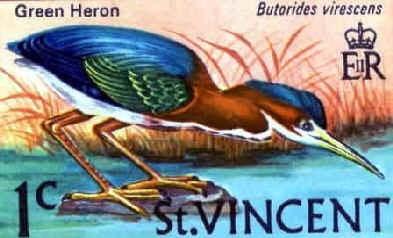
On a postage stamp, the Green Heron
- Striated Heron (WIr) (ph) ______
SL(very rare) VI(very rare)
Butorides striata
The northernmost record of the Striated Heron was a bird, photographed,
on St. John in the US Virgin Islands in May 2003.
- Western Cattle Egret (*) (ph) ______
AT:feb
BH BD:jul BU:feb
CU
CY:feb,dec DM:jan,mar DR:jan,feb,mar,apr,jul,dec GD:feb JM:mar,apr
MN
PR:feb,mar,apr SL:mar,dec SV:mar,jul,dec
Bubulcus ibis
The Western Cattle Egret is in parts of Europe and
Africa, and now in much of the Americas. The Eastern Cattle Egret, Bubulcus
coromandus, is in eastern Asia.
The Western Cattle Egret arrived, apparently on its own, in northern
South America from Africa in the 1950s, and soon thereafter it spread rapidly
through the West Indies.
In Jamaica, a local name for the Western Cattle Egret is "Tick
Bird".

Cattle Egret
(photo by Howard Eskin)
- Snowy Egret (*) (ph) ______
BH BD:jul CU
CY:feb,jun,dec DM:jan,mar DR:jan,feb,mar,apr,jul,dec GD:feb
HA JM:mar,apr MN
PR:feb,mar,apr SL:mar,dec
Egretta
(formerly Leucophoyx) thula brewsteri
In Jamaica, a local name for the Snowy Egret is "Golden
Slippers".

Snowy Egret, with red lores in breeding plumage
(photo by Howard Eskin)
- Little Egret (*) (ph) ______
AT(rare)
BD:jul DM:mar(rare) GD(rare)
SL:dec(rare)
SV:jul(rare)
Egretta g. garzetta
As of 2001, there were 33 records of the Little Egret in Trinidad
& Tobago.
In a report published in 2009 in "Caribbean Ornithology", it was
noted that the Little Egret has become a breeder on a second island in
the West Indies, on Antigua (following Barbados).
In addition to being the second island, Antigua became the second breeding
location in the Western Hemisphere for the normally Old World
species

Little Egret
(photo by Howard Eskin)
- Little Blue Heron (*) (ph) ______
BH
CU CY:feb,jun,dec DM:jan,mar
DR:jan,feb,mar,apr,jul,dec GD:feb HA:apr JM:mar,apr
MN PR:feb,mar,apr SL:mar,dec
SV:mar,jul,dec
Egretta
(formerly Florida) caerulea (monotypic)
In Jamaica, a local name for the Little Blue Heron is "Blue
Gaulin".

An adult Little Blue Heron photographed during a FONT tour
- Tricolored Heron
(*) (ph) ______ BH CU CY:feb,jun,dec DR:jan,feb,mar,apr,jul,dec
GD GR(rare) HA:apr
JM:mar,apr PR:feb,mar,apr SL:mar
Egretta (formerly Hydranassa) tricolor ruficollis
The Tricolored Heron was called the Louisiana Heron.
Several Tricolored Herons in Grenada, at Telescope Marsh, in
December 2005 were thought to be "new" for that island.
-
Reddish Egret (*) (ph) ______ BH CU
DR:feb,mar,apr,jul,dec
HA PR:feb(rare)
SL(very rare)
Egretta
(formerly Dichromanassa) r. rufescens
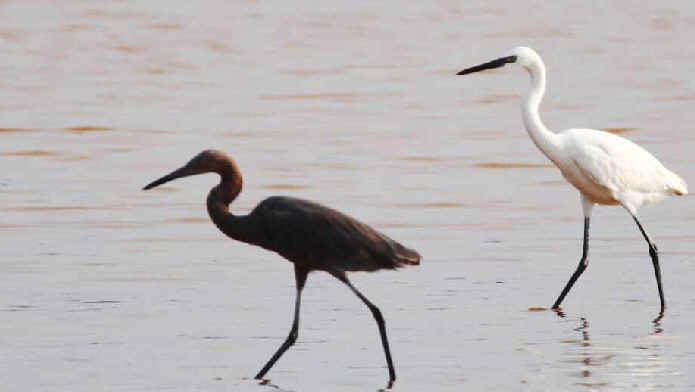
Reddish Egrets of both the dark & white morphs
during the FONT tour
in the Dominican Republic in April 2012
(photo by Marie Gardner)
Most, nearly all, of the Reddish Egrets that have been seen during the FONT
tours
in the Dominican Republic have been white birds.
- Western Reef Heron (WIr) ______
BD(rare) PR(very rare, on Culebra Is.) SL(very
rare) SV(very rare)
Egretta gularis
A dark-morph Western Reef Heron on the island of Mustique on June 24,
2004 was a first record for Saint Vincent and the Grenadines.
- Black-crowned Night Heron (*) (ph) ______
BH
CU CY DR:feb,mar,apr,jul GD
JM:mar,apr PR:mar,apr SL:mar
Nycticorax nycticorax hoactii
In Jamaica, a local name for the Black-crowned Night Heron is "Quok".
-
Yellow-crowned Night Heron (*) (ph) ______ BH CU
CY:feb,jun,dec
DM:mar DR:apr,jul,dec GD JM:apr PR:feb,mar SL:mar SV
Nyctanassa violacea bancrofti
(the single member of its genus)
In Jamaica, a local name for the Yellow-crowned Night Heron is "Crab-catcher".

Above: an immature Yellow-crowned Night Heron during
the FONT tour in April 2012
in the Dominican Republic, not far from the Haitian border
(photo by Marie Gardner)
Below, 2 Yellowed-crowned Night Herons even more immature, just out of the nest,
photographed in the Dominican Republic in 2014

-
Least Bittern (*) (ph) ______ BH CU
CY:jun,dec DR:mar,apr
JM:mar,apr PR:feb,mar SL(rare)
Ixobrychus e. exilis
-
American Bittern (*) (ph) ______ BH CU
PR(rare) SL(very
rare)
Botaurus lentiginosus
TROPICBIRDS, FRIGATEBIRD, PELICANS, BOOBIES
- Red-billed Tropicbird
(*) (ph)
______ BU:feb CU(rare)
GD MN SL:mar,dec
Phaethon aethereus mesonauta

Red-billed Tropicbird
(a black-and-white photo by Alan Brady)
- White-tailed Tropicbird (p) (*) (ph) ______ BH CU CY:feb DM:mar DR:mar,apr
JM:apr MN PR:feb,apr
SL(rare) SV
Phaethon lepturus catesbyi
In Jamaica, a local name for the White-tailed Tropicbird is "Bo'sun
Bird".

Above & below: White-tailed Tropicbirds
Above: a black-and-white photo by Alan Brady
Below: a White-tailed Tropicbird photographed during the April 2012 FONT
tour
in the Dominican Republic

- Magnificent Frigatebird (p) (*) (ph) ______ AT:feb BH
BU:feb(a nesting colony) CU CY:feb(a
nesting
colony at Little Cayman Is.),jun,dec DM:jan,feb,mar
DR:jan,feb,mar,apr,jul,dec GD GR JM:mar,apr
MN
PR:feb,mar,apr SL:mar,dec
SV:mar,jul,dec
Fregata magificens (now said to be monotypic)
A colloquial name for the Magnificent Frigatebird is the "Man
o' War Bird".
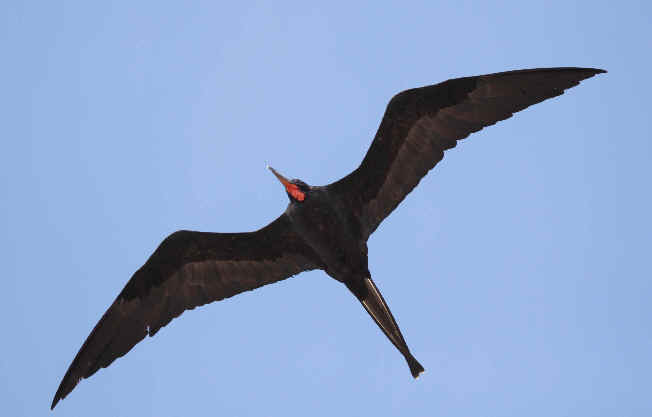
All of the photos, in this set of Magnificent
Frigatebirds, were taken during FONT tours.
The first 3 photos were during a tour in 2014.
Above: an adult male, notice the red throat
Below: an adult female (all of the photos here of frigatebirds by
Marie Gardner)

Below: a juvenile Magnificent Frigatebird

And, lastly, below: a lone Magnificent Frigatebird
roosting at the end of the day
on a small island in a lake near the sea.
Seen from a late-day boat trip during a FONT tour in the Dominican
Republic.
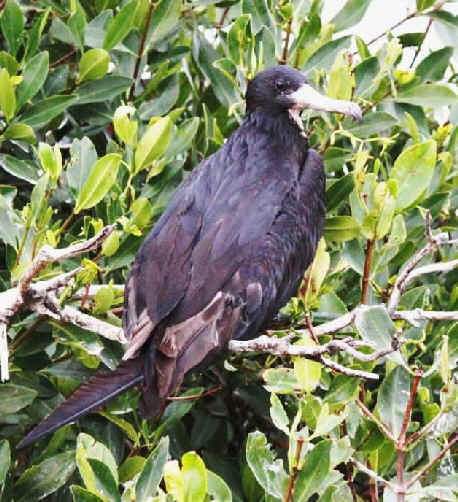
-
Brown Pelican (p) (*) (ph) ______ AT:feb
BH
BU:feb CU
CY:feb,dec DM:jan,feb,mar
DR:feb,mar,apr,jul,dec GD:feb JM:mar,apr MN
PR:feb,mar,apr SL
Pelecanus o. occidentalis the "Caribbean Brown
Pelican"
In Jamaica, a local name for the Brown Pelican is "Old
Joe".
- American White Pelican (ph) ______
BH(rare) CU(rare)
Pelecanus erythrorhynchos
- Masked Booby (mi) (*) ______
BH(rare)
CU(rare) PR SL(rare)
Sula d. dactylatra
-
Brown Booby (p) (*) (ph) ______ BH
BU:feb CU
DM:mar DR:mar,apr GD MN
PR:feb,mar,apr SL:mar,dec SV:jul,dec
Sula l. leucogaster
-
Red-footed Booby (p) (*) (ph) ______ BH
CU(rare) CY:feb(a
nesting
colony at Little Cayman Is.) DM:mar(at sea) GD
PR SL
SV:jul
Sula s. sula
A pair of white-morph Red-footed Boobies with a single chick were at a
small cay off San Salvador Island on April 28, 1995. The birds were
photographed and were thus the first confirmed breeding record for the species
in the Bahamas during the 20th century. The species had been noted in that
same area in 1986.

A Red-footed Booby photographed during a FONT
pelagic trip off Puerto Rico
- Northern Gannet (ph) ______
BH(rare) CU(rare)
Morus bassanus
CORMORANTS and ANHINGA
- Neotropic Cormorant (*)
(ph) ______ BH CU
JM:jun(rare)
SL(very rare)
Phalacrocorax brasilianus mexicanus
The Neotropic Cormorant was called the Olivaceous Cormorant.
- Double-crested Cormorant (ph) ______
BH
CU SL(very
rare)
Phalacrocorax auritus
- Anhinga (ph) ______
BD(very rare) BH(rare) CU
SL(very rare)
Anhinga anhinga
An Anhinga in Barbados first found in October 2006 was the first
record of the species for that island. The bird stayed several
months.
RAPTORS (including
VULTURES)
- Turkey Vulture (*) (ph) ______
BH
CU DR:feb,mar,apr JM:mar,apr
PR:feb,mar,apr
Cathartes a. aura
In Jamaica, a local name for the Turkey Vulture is "John
Crow".
-
Black Vulture (ph) ______ BH(rare) CU(rare)
Coragyps atratus
-
Northern Crested Caracara (ph) ______
CU
Caracara cheriway
-
Merlin (*) (ph) ______ AT:feb
BH
BU:feb CU CY:dec DM:jan,mar DR:feb,mr,apr,dec
GD
JM:mar PR:mar SL:mar SV:mar,dec
Falco c. columbarius
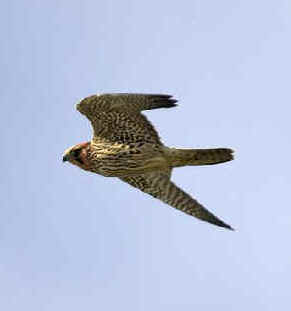
A Merlin in flight
-
American Kestrel (*) (ph) ______ BH
BU:feb
CU
CY:dec DM:mar
DR:jan,feb,mar,apr,jul,dec GD:feb JM:mar,apr MN
PR:feb,mar,apr SL:mar,dec SV:mar
Falco sparverius dominicensis (subspecies endemic to Hispaniola)
Falco sparverius sparveroides (subspecies
in Jamaica, the Caymans, Cuba, & the southern Bahamas)
Falco sparverius caribaearum
(subspecies in
Puerto Rico & in the Lesser Antilles)
(These Caribbean subspecies are resident.)
In Jamaica, a local name for the American Kestrel is "Killy-killy".

An American Kestrel photographed outside a hotel room window
in Jamaica in November 2012
(photo courtesy of Suzanne Bradley)
-
Peregrine Falcon (*) (ph) ______ BH
CU
CY:dec DM DR:feb,mar,apr GD
MN
PR:mar SL SV:mar
Falco peregrinus anatum
(from North America)
Falco peregrinus tundrius
(from North America, north of F.p.anatum)

A Peregrine Falcon that flew about at dusk above a
pond filled with ducks.
It was observed during a boat-trip, late that day, that was part of the
FONT Dominican Republic Tour in April 2102.
An alternate name for the Peregrine Falcon has been "Duck Hawk",
and that day that name was appropriate.
(photo by Marie Gardner)
- Aplomado Falcon (WIr) (ph)
______ PR(very rare)
Falco femoralis
A well-documented Aplomado Falcon in southwestern Puerto Rico
in January 2008 was a first record for not only Puerto Rico but for anywhere
in the West Indies.
- Osprey (*) (ph) ______
BH BU:feb CU
CY:feb,dec DM:feb,mar DR:jan,feb,mar,apr,dec GD:feb HA:apr
JM:mar PR:feb,mar,apr SL:mar,dec
Pandion haliaetus (2 subspecies occur in the Caribbean) (the
single member of its genus)
Pandion
haliaetus carolinensis (migrant
North American breeder)
Pandion haliaetus ridgwayi (breeder in Caribbean area)

Osprey
(photo by Kim Steininger)
- Hook-billed Kite (WIr) ______
GR(very rare)
Chondrohlerax uncinatus
- Cuban Kite (t1) ______ CU(rare)
(species endemic to Cuba)
Chondrohlerax wilsonii
The very rare Cuban Kite was observed in far-eastern Cuba,
in the area of the Alejandro de Humboldt National Park in 2004, and then later
in December 2009 when the bird was photographed.
- Swallow-tailed Kite (ph) ______
BH(rare) CU
HA(rare)
Elanoides forficatus
Two Swallow-tailed Kites were among a large movement of Osprey
in Haiti on August 28, 1999. That was said to be the first record of Swallow-tailed
Kite for the island of Hispaniola.
- Snail Kite (ph) ______ CU
Rostrhamus sociabilis
- Mississippi Kite (WIr)
______ CU(very
rare)
Ictinia mississippiensis
A Mississippi Kite in Havana province, Cuba on
April 17, 1999 was a first for both Cuba and the West Indies.
The third Mississippi Kite for Cuba (and the fourth for the Greater
Antilles) was seen flying over Zapata on March 30, 2010.
- Sharp-shinned Hawk (*) (ph) ______
BH
CU DR:feb,mar,apr,jul
PR:feb VI(rare)
Accipiter s. striatus (t3) (this subspecies,
the nominate, endemic to Hispaniola)
Accipiter striatus venator
(t2) (subspecies endemic to Puerto
Rico)
A Sharp-shinned Hawk on Guama Island on October 28, 1998 was
said to be the first record for British Virgin Islands.

A male Sharp-shinned Hawk of the endemic subspecies
in Puerto Rico
- Gundlach's Hawk (t2) ______
CU (species
endemic to Cuba)
Accipiter gundlachi
- Northern Harrier (ph) ______
BH CU CY:dec
Circus hudsonius
- Western Marsh Harrier (WIr)
______ GD(very rare)
Circus
aeruginosus
A Western Marsh Harrier, a
bird of the Old World, was in Guadeloupe from November 2002 to April
2003. That occurrence was the first record for the Western
Hemisphere.
- Red-tailed Hawk (*) (ph) ______
BH
CU DR:feb,mar,apr,jul,dec
JM:mar MN(rare)
PR:feb,mar,apr
Buteo j. jamaicensis (this
subspecies, the nominate, on Hispaniola, Jamaica, & Puerto Rico)

A Red-tailed Hawk in flight, Buteo jamaicensis
(photo by Doris Potter)
- Ridgway's Hawk
(t1) (*) ______ DR:mar,apr (species
endemic
to the Dominican Republic on Hispaniola)
Buteo ridgwayi (monotypic)
Regarding the RIDGWAY'S HAWK, go to: RARE BIRDS OF THE CARIBBEAN
- Broad-winged Hawk (*) (ph) ______
AT:feb CU
DM:jan,feb,mar GD
GR PR:feb SL:mar,dec SV:mar,dec
Buteo platypterus antillarum (subspecies on Barbados, Grenada, St.
Vincent, & Tobago)
Buteo platypterus brunnescens
(t3)
(subspecies
endemic to Puerto Rico)
Buteo platypterus cubanensis (subspecies endemic to Cuba)
Buteo platypterus insulicola (t3) (subspecies endemic to Antigua)
Buteo platypterus rivierei (subspecies on Dominica, St. Lucia, &
Martinique)
(All 5 subspecies in the Caribbean are resident.)
- Swainson's Hawk (ph) ______
DR(very rare)
Buteo swainsoni
A light-morph Swainson's Hawk seen in the Dominican Republic, near
Monte Cristi along the north coast, on April 22, 1996, was said to be the first record of
the species in the West Indies.
What was said to be the first record of a Swainson's Hawk in Trinidad
was in May 1998. The following year, there was a Swainson's Hawk at Chacachacare
Island (near Trinidad) from October 1999 to January
2000.
- Common Black Hawk (*) (ph) ______
CU SL(rare)
SV:mar,jul,dec
Buteogallus a. anthracinus
In the Caribbean, Buteogallus anthracinus is also known as the
"Black Crab Hawk".

Common Black Hawk
RAILS, CRAKES, GALLINULES, COOTS
-
Black Rail (nt) ______ BH(rare) CU
Laterallus jamaicensis
-
"Antillean" Clapper Rail (*) (ph) ______
BH CU DR:apr,jul GD
JM PR:mar,apr SL(rare)
Rallus crepitans caribaeus
In Jamaica, a local name for the Clapper Rail is "Mangrove
Hen".

An "Antillean Clapper Rail"
photographed during the FONT tour
in the Dominican Republic in April 2012
(photo by Marie Gardner)
- King Rail ______ CU
CY:dec
Rallus elegans
- Virginia Rail (ph) ______ BH CU(rare)
Rallus limicola
- Yellow-breasted Crake (*) ______
CU DR:apr
JM,PR
Porzana flaviventer hendersoni
(subspecies in Hispaniola & Puerto Rico)
Porzana flaviventor gossi (subspecies in Jamaica & Cuba)
In Jamaica, a local name for the Yellow-breasted Crake is the "Twopenny
Chick".
-
Sora (*) ______ BH CU
DR GD
MN PR:apr
SL(rare)
Porzana carolina
(monotypic)
- Zapata Rail (t2) ______ CU
(species endemic to Cuba)
Cyanolimnas cerverai
- Spotted Rail (*) _____
CU DR:apr JM
Pardirallus m. maculatus
A Spotted Rail heard near Kingston, Jamaica in January 1999 was
said to be only the second record for the island in that decade.
- Uniform Crake ______ (species
occurred
formerly in Jamaica)
Amaurolimnas concolor
- Purple Gallinule (*) (ph) ______
BH
CU CY:jun
DR:mar,apr,dec GD GR(rare) JM:mar,apr
MN PR:apr
SL(rare)
Porphyrula martinica
(monotypic)
Rare on Grenada, a Purple Gallinule was on that
island in October 2010.

Purple Gallinule
(photo by Marie Gardner)
- Common Gallinule
(*) (ph) ______ BD:jul BH
BU:feb CU CY:feb,jun,dec DM:mar
DR:jan,feb,mar,apr,jul,dec GD:feb HA:feb,apr JM:mar,apr
PR:feb,mar,apr
SL:mar,dec SV
Gallinula galeata cerceris
-
American Coot (*) (ph) ______ BH CU
CY:feb,jun,dec DR:feb,apr GD
HA:feb JM:mar,apr MN PR:apr
SL(rare)
Fulica a. americana
-
"Caribbean Coot" (nt) (*) ______ CU(rare)
DR:feb,mar,apr,dec GD
HA:feb,apr JM:mar,apr MN NA PR:feb,mar,apr
SL(rare) SV(rare)
Fulica caribaea
The Caribbean Coot has been considered by some to be conspecific with the
American Coot.
2 Caribbean Coots were in Saint Lucia from late April to at
least mid-May in 2009.
The species, a rare visitor to the island, has been seen, in earlier years,
during FONT tours on Saint Lucia.
The Caribbean Coot occurs on all three islands of the Netherlands
Antilles.
- Limpkin (*) (ph) ______
BH CU CY
DR:mar,apr
JM:mar,apr
Aramus guarauna elucus (t3) (subspecies now endemic to Hispaniola,
as it has been extirpated in Puerto Rico)
Aramus guarauna pictus (subspecies in Jamaica, Cuba, & Florida USA)
(the single member of its genus & family)
The first Limpkin ever seen in the Cayman Islands was found
there in April 2010 on Grand Cayman by a school off Walkers Road, where it was
seen feeding on invasive garden snails and the larvae of the Japanese
beetle.
Later, in June 2010, there was a Limpkin sighting at the Botanic Park
on Grand Cayman.
- Sandhill Crane (ph) ______ CU
Grus canadensis nesiotes (resident
subspecies endemic to Isla de la Juventud in Cuba)
SHOREBIRDS
- Double-striped Thick-knee (ph) ______
BH DR
Burhinus bistriatus dominicenis (subspecies on
Hispaniola, normally the only place for it in the West Indies)
In the West Indies, the Double-striped Thick-knee has been
thought to be a resident only on Hispaniola. but a pair was found breeding on
Great Inagua Island, in the Bahamas, in 2003.
- Northern Jacana (*) (ph) ______
CU DR:mar,apr,dec
GR(rare) JM:mar,apr
Jacana spinosa violacea (subspecies in the Caribbean: in Hispaniola,
Jamaica, & Cuba)
In Jamaica, a local name for the Northern Jacana is "River
Chink".
Single Northern Jacanas were at two different locations on
Grenada in October 2010.
- American Oystercatcher (*) (ph) ______
BH
CU GD PR:mar
SL(rare)
Haematopus p. palliatus
- Black-bellied (or Grey) Plover
(*) (ph) ______ BH CU CY:feb,jun,dec DR:feb,mar,apr,jul,dec
GD JM:mar MN
PR:feb,mar,apr
SL:mar,dec
Pluvialis squatarola cynosurae
- American Golden Plover (*) (ph) ______
BH
CU DR(rare) GD MN SL:dec
Pluvialis dominica (monotypic)
An American Golden Plover was at Lago Enriquillo in the Dominican
Republic in September 1999.

American Golden Plover
(photo by Howard Eskin)
- Semipalmated Plover (*) (ph) ______ BD:jul
BH CU
CY:feb,jun DR:feb,mar,apr,dec GD
JM:mar MN
PR:feb,mar,apr SL:dec
Charadrius semipalmatus (monotypic)
- Common Ringed Plover (WIr) (ph)
______ SL(very
rare)
Charadrius hiaticula
- Snowy Plover (*) (ph) ______ BH CU(rare)
DR:feb,mar,apr,dec GD(rare) PR(rare)
SL(rare)
Charadrius n. nivosus (t3)
The Snowy Plover was conspecific with the Kentish Plover of
Eurasia.
A Snowy Plover was in Guadeloupe on September 30, 2008.

A Snowy Plover photographed during the FONT tour
in the Dominican Republic in February 2012
(photo by Marie Gardner)
- Wilson's Plover (*) (ph) ______
BD:jul BH
CU
CY(rare) DR:feb,mar,apr,jul,dec
GD HA:apr JM:mar
MN
PR:feb,apr SL(rare)
Charadrius wilsonia rufinucha (resident subspecies in the Caribbean)

Two Wilson's Plovers during the FONT tour in the
Dominican Republic in April 2012
(photo by Marie Gardner)
- Piping Plover (nt) (ph) ______
BH CU NA
Charadrius melodus
- Collared Plover (WIr) ______
GD(very rare) GR SL(very rare)
Charadrius collaris
The Collared Plover is a rare to uncommon breeding resident on
Grenada, and possibly in the Grenadines on Mustique.
A Collared Plover was in Guadeloupe on September 30, 2008.
- Killdeer (*) (ph) ______ BH CU
CY:feb
DR:jan,feb,mar,apr,jul,dec GD
HA:apr JM:mar,apr MN
PR:feb,mar,apr SL(rare)
Charadrius vociferus ternominatus (resident subspecies in the
Caribbean)
Charadrius v. vociferus (North American breeder that occurs in the
Caribbean outside the breeding season)
- Northern Lapwing (WIr) (ph) ______
BH(very rare) SL(very
rare)
Vanellus vanellus
- Southern Lapwing (WIr) (ph)
______ BD(very rare)
Vanellus chilensis
A Southern Lapwing in Barbados on July 28, 1998 was the
first record for the West Indies.
- Black-necked Stilt (*) (ph) ______
BH BU:feb CU
CY:feb,jun,dec
DR:feb,mar,apr,jul,dec GD HA:apr JM:mar,apr
MN PR:mar,apr
SL(rare)
Himantopus mexicanus
The Black-necked Stilt has been said by some to
be conspecific with the Black-winged Stilt of the Old World, Himantopus
himantopus.
In Jamaica, a local name for the Black-necked Stilt is "Captain
Lewis".
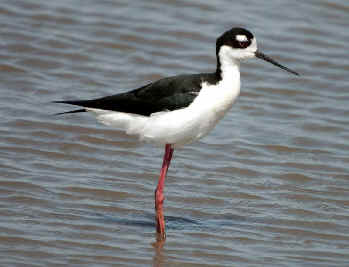
Black-necked Stilt
(photo by Howard Eskin)
- American Avocet (ph) ______
BH(rare) CU(rare)
SL(very rare)
Recurvirostra americana
- Hudsonian Godwit (*)
(ph) ______ BH(rare)
CU(rare)
DR:apr (a sighting in April, rare in the Caribbean in the spring)
SL(rare)
Limosa haemastica (monotypic)
- Marbled Godwit (ph) ______
CU(rare) SL(very
rare)
Limosa fedoa
- American" Whimbrel (*)
(ph) ______ BH CU(rare)
DR:apr GD
MN
PR:feb SL
Numenius phaeopus hudsonicus
Historically, Numenius phaeopus
hudsonicus was called the "Hudsonian Curlew".
THE FOLLOWING REGARDING WHIMBRELS IS FROM THE
TEXT OF A "BIRDLINE",
written by Armas Hill in September 2011:
Some Whimbrels are being tracked (in 2011) as they do their long
migration, with satellite transmitters that they carry as backpacks.
According to the William & Mary Center for Conservation Biology (CCB),
one such Whimbrel, with such a transmitter, left the upper Hudson Bay
(in Canada) on Saturday, August 20, 2011.
That bird flew out over the open ocean and encountered the outer bands of Hurricane/Tropical
Storm Irene on Tuesday, August 23.
The bird flew through the dangerous northeast quadrant of the storm during the
day on Wednesday, August 24. It made it through the storm, and continued its
journey over the open ocean to the islands in the Caribbean.
During the week of September 4, 2011, that bird was shot on the West Indian
island of Guadeloupe, where it had landed to feed in a mangrove marsh.
That same bird, by the way, flew around a storm the previous year (Tropical
Storm Colin in 2010), when a second bird flew into that storm and did not
survive.
To give an idea of what flying through a hurricane or tropical storm is a like
for such a shorebird:
Early in August 2011, another Whimbrel survived passage through Tropical
Storm Gert, where the storm was strong. It was a rare tropical storm off
Nova Scotia, Canada.
The bird encountered headwinds for 27 hours, averaging, during that time, a
flying speed of only 9 miles per hour.
Once through the storm, her flight speed increased to over 90 miles per hour,
and she was pushed by significant tail winds, making it back to shore at Cape
Cod, Massachusetts.
- Long-billed Curlew (nt) ______
CU(rare)
Numenius americanus
- Eskimo Curlew (t1) ______
(species now presumed extinct)
Numenius borealis
Regarding the ESKIMO CURLEW, go to: RARE BIRDS OF THE CARIBBEAN
- Upland Sandpiper ______ BH CU(rare)
GD MN
Bartramia longicauda
- Spotted Sandpiper (*) (ph) ______
BH
CU CY:feb,dec
DM:jan,mar DR:jan,feb,mar,apr,dec GD:feb HA:apr JM:mar,apr
MN
PR:feb,mar,apr SL:mar,dec
SV:dec
Actitis macularia (monotypic)

A Spotted Sandpiper in its non-breeding plumage
(photo by Kim Steininger)
- Solitary Sandpiper (*) (ph) ______
BH
CU CY:feb
DR:jan,feb,mar,apr,dec GD HA:apr JM:mar
MN PR:apr SL:mar,dec SV
Tringa s. solitaria
-
Greater Yellowlegs (*) (ph) ______ BH
BU;feb
CU
CY:feb,dec DM
DR:feb,mar,apr,jul,dec GD HA JM:mar,apr
MN PR:feb,mar,apr SL:mar,dec
Tringa melanoleuca (monotypic)
-
Lesser Yellowlegs (*) (ph) ______ BH BD:jul
CU CY:feb,dec DM:feb DR:feb,mar,apr,dec
GD HA JM:mar
MN PR:feb,mar,apr SL:dec
Tringa flavipes
(monotypic)
- Common Greenshank (WIr)
______ BD(very rare)
Tringa nebularia
A Common Greenshank was in Barbados in November
1996.
- Spotted Redshank (WIr)
______ BD(very rare) SL(very
rare)
Tringa erythropus
A Spotted Redshank found on the island of Tobago (of Trinidad
& Tobago) on February 13, 1983 was the first record for that island (and
considered the first record for South America).
That Old World wader (or shorebird) has also occurred occasionally further
north in the Caribbean on Barbados.
- Wood Sandpiper (WIr)
(*) (ph) ______
BD:jul(rare) SL(very
rare)
Tringa glareola
Single Wood Sandpipers were in Barbados in 1998 in April and in
November/December.
- Willet (*) (ph) ______
BH
CU
CY:feb DR:feb,mar,apr,dec GD:feb
JM:mar MN
PR:apr SL
Tringa
(formerly Catoptrophorus) s. semipalmata

Willet
(photo by Howard Eskin)
- Ruddy Turnstone (*)
(ph) ______ BD:jul BH
CU
CY:feb,dec DM:mar DR:feb,mar,apr,jul,dec GD
JM:mar MN
PR:apr SL:mar,dec
Arenaria interpres morinella
On September 16, 2008, a "famous" Ruddy Turnstone, named
"Luc", returned to Guadeloupe for its 8th time to
winter.

A Ruddy Turnstone in non-breeding plumage
(photo by Howard Eskin)
-
Semipalmated Sandpiper (*) (ph) ______ BD:jul
BH CU
CY
DR:feb,mar,apr,jul,dec GD HA JM:mar,apr
MN PR:feb,apr SL
Calidris pusilia
(monotypic)
- Western Sandpiper (*) (ph) ______
BH
CU DR:feb,mar,apr GD
JM:mar PR SL:mar
Calidris mauri
(monotypic)
- Least Sandpiper (*) (ph) ______
BH
CU CY
DR:feb,mar,apr,dec GD HA JM:mar PR:feb,apr
MN SL
Calidris minutilla (monotypic)
- White-rumped Sandpiper (*) (ph) ______
BH
CU DR:feb,apr
GD
MN PR(rare)
SL
Calidris fuscicollis
(monotypic)
- Sanderling (*) (ph) ______ BH
CU DR:feb,mar,apr,dec GD
JM:mar MN PR:apr SL
Calidris alba rubida
- Dunlin (*) (ph) ______ BH CU(rare)
DR:dec(rare) SL(rare)
Calidris alpina hudsonia
The observation of a Dunlin during a FONT Dominican Republic tour in December
1998
(referred to in a note at
the
end of this page) was said to be only the second record
for the species in the Dominican Republic.
The bird was along the south coast at Las Salinas.
- Red Knot (*)
(ph) ______ BH CU
MN PR SL(rare)
Calidris canutus rufa
- Pectoral Sandpiper (ph) ______
BH CU GD
MN SL
Calidris melanotos
On September 25, 2008, there was a high count of 185 Pectoral
Sandpipers on Guadeloupe.
- Baird's Sandpiper (ph) ______
CY(rare) DR(rare)
SL(rare)
Calidris bairdii
A Baird's Sandpiper on Grand Cayman Island in May 1999 was said
to be the first record of the species for that island, and a rarity in that
part of the Caribbean.
A Baird's Sandpiper was at Cabo Rojo in the Dominican Republic
in September 1999.
- Curlew Sandpiper (WIr) (ph) ______
SL(very rare)
Calidris ferruginea
- Little Stint (WIr) ______
BD(rare)
Calidris minuta
A Little Stint photographed on Barbados in May 1999 was said
to be second record of the species for that island.
- Terek Sandpiper (WIr)
______
Xenus cinereus
A Terek Sandpiper, seen by multiple observers, in Trinidad on
June 28, 1999 was the said to be the first record of that Old World species
for Trinidad & Tobago and possibly the Caribbean.
In the Neotropics, prior to that, there were said to be 3 previous records for
the species, with 2 in Argentina and 1 in Brazil.
- Short-billed Dowitcher (*) (ph) ______
BH
CU DR:feb,mar,apr,dec
GD
JM:mar MN PR:mar
Limnodromus griseus (2 subspecies in the West Indies: L. g. grieus &
L. g. hendersoni)

Short-billed Dowitcher
(photo by Howard Eskin)
- Long-billed Dowitcher (*) ______
CU(rare) HA
Limnodromus scolopaceus
(monotypic)
- Ruff / Reeve (WIr) (*) (ph) ______ BD:jul(rare)
SL(very rare)
Philomachus pugnax
(monotypic, and the single member of its genus)
3 Ruffs overwintered in Barbados in
1998/99.
- Stilt Sandpiper (*) (ph) ______
BH
CU DR:feb,mar,apr,dec
GD
PR SL(rare)
Calidris
(has been
Micropalama)
himantopus
(monotypic)
A Stilt Sandpiper in Saint Lucia on September 22, 2001 was
said to be the ninth record for the island.
- Buff-breasted Sandpiper (nt) (ph) ______
BH(rare)
CU(rare) SL(rare)
Tryngites subruficollis
A Buff-breasted Sandpiper in Saint Lucia on September 22, 2001
was said to be the second record for the island.
- Wilson's Snipe (*) (ph) ______
BH
CU
CY DM GD JM:mar SL
Gallinago delicata (monotypic)
Until recently, the Wilson's Snipe was conspecific with the
Common Snipe of the Palearctic, Gallinago
gallinago.
- Jack Snipe (WIr) ______ SL(very
rare)
Lymnocryptes minimus
- Wilson's Phalarope (*) ______
BD(rare) BH(rare)
DR:feb SL(rare)
Phalaropus (formerly Steganopus) tricolor
(monotypic)
A Wilson's Phalarope was in Barbados in November
2005.
- Red-necked Phalarope (ph) ______
BH(rare) CU(rare)
Phalaropus lobatus
- Red Phalarope (ph) ______ CU(rare)
Phalaropus fulicarius
- Collared Pratincole (ph)
______ BD(very rare)
Glareola
pratincola
A Collared Pratincole, in Barbados,
from October 1996 to January 1997, was the first in the Neotropics.
GULLS, TERNS, SKIMMER, JAEGERS
- "American" Herring Gull
(*) ______ BH CU DR:feb,apr PR
SL(rare)
Larus argentatus smithsonianus
-
Great Black-backed Gull (*) (ph) ______ BH(rare) CU(rare)
DM(rare)
PR(rare)
SL(rare)
Larus marinus
(monotypic)
A Great Black-headed Gull at New Providence Island in
March 1998 was said to be the fifth record for the Bahamas.
A Great Black-backed Gull in Barbados in December 1998 was
said to be the sixth record for that island.
A Great Black-backed Gull in Dominica at Mahaut on March 9, 1999
was said to be the first record of the species for that
island.
- Ring-billed Gull (*) (ph) ______
BH
CU DM:jan
DR:mar,apr GD(rare) PR
SL(rare)
Larus delawarensis (monotypic)
- Lesser Black-backed Gull (*) (ph)
______ AT(very rare) BD(rare) BH
CU(rare) DM:mar(during
our tours, 2
consecutive years)
DR:apr,jul GD(rare)
PR SL(rare)
Larus fuscus
One of the first Lesser Black-backed Gulls found in Dominican
Republic was at Las Salinas, along the south coast, in November 1997.
Lesser Black-backed Gulls have been seen during FONT Dominican Republic
tours in July 1995 (at Lago Enriquillo) and April 2008 (at
Las Salinas).
A Lesser Black-backed Gull on Cayo Romano in April 2000 was said to
be the second record of the species, and the first documented record of it for
Cuba.
A Lesser Black-backed Gull was on Barbados in November
2005.
A Lesser Black-backed Gull was on Guadeloupe in September
2008.
A first-summer Lesser Black-backed Gull was on Antigua at St. John's
Harbor on March 31, 2009. It was photographed.
- Kelp Gull (ph) ______
Larus dominicanus
Kelp Gulls
that have been reported on Barbados and Trinidad have been birds from the
African population, Larus dominicanus
vetula, rather than from South America.
- Laughing Gull (*) (ph) ______
BH
CU CY:jun
DM:feb,mar
DR:feb,mar,apr,jul GD JM:apr MN PR:apr SL:mar SV:jul
Leucophaeus
(formerly Larus) a. atricilla

Laughing Gulls
(photo by Howard Eskin)
- Franklin's Gull (WIr) (ph)
______ BD(very rare) CU(very
rare) DR(very rare)
GD(very rare) PR(very rare)
Leucophaeus (formerly Larus) pipixan
The first Franklin's Gull reported in Cuba was at Havana in
April 1999.
The first Franklin's Gull reported in Barbados was on November 9,
2005.
- Black-headed Gull (WIr) (ph) ______
BH(rare) CU(rare)
GD(rare)
PR(rare) SL(rare)
Chroicocephalus
(formerly
Larus)
ridibundus
An immature Black-headed Gull at New Providence Island in
January 1999 was said to be the third record in the Bahamas.
- Bonaparte's Gull (*) (ph) ______
BH CU DR:mar
SL(rare)
Chroicocephalus
(formerly Larus) philadelphia
A Bonaparte's Gull was seen during the FONT Dominican Republic Tour
in March 2008 at Las Salinas along the south coast.
- Little Gull (WIr) (ph) ______ BD(very
rare)
Hydrocoloeus minutus
A Little Gull in Barbados in December 1998 was thought to be
the first record for the West Indies.
- Black-legged Kittiwake (WIr) (ph)
______ BD(very rare) BH(rare)
CU(rare) DM(very rare) GD(very rare)
SL(very rare)
Rissa tridactyla
A dead Black-legged Kittiwake was washed up on a beach on Dominica
in February 2009. There were also records for the species (alive) for
Guadeloupe and Barbados around that time.
- Gull-billed Tern
(*) (ph) ______ BH CU CY:dec DR:mar,apr,dec
GD JM:apr(rare)
SL(rare)
Gelochelidon
(formerly Sterna) nilotica aranea
- Common Tern
(p) (*) ______ BH CU DR:apr,dec
GD MN PR
SL
Sterna h. hirundo
-
Roseate Tern (p) (*) (ph) ______ BH CU
DR:mar,apr GD
PR SL
Sterna d. dougallii (t3)

Roseate Tern
(photo by Alan Brady)
- Forster's Tern (ph) ______ BH CU
Sterna forsteri
- Arctic Tern (ph) ______
Sterna paradisaea
- Bridled Tern (p) (*) (ph) ______
BH
CU GD MN PR
SL
Onychoprion
(formerly Sterna) anaethetus melanoptera

Bridled Tern
(photo by Alan Brady)
-
Sooty Tern (p) (*) (ph) ______ BH CU
DM GD
PR SL
Onychoprion
(formerly Sterna) f. fuscata

Sooty Tern
(photo by Alan Brady)
-
Least Tern (*) ______ BH CU
CY:jun DR:mar,apr,jul
GD PR SL
Sternula
(formerly Sterna) a. antillarum
-
Royal Tern (*) (ph) ______ AT:feb BH
CU
CY:feb,jun,dec DM:jan,feb,mar
DR:jan,feb,mar,apr,jul,dec GD:feb JM:mar,apr PR:feb,mar,apr SL:mar,dec SV:dec
Thalasseus
(formerly Sterna) m. maxima
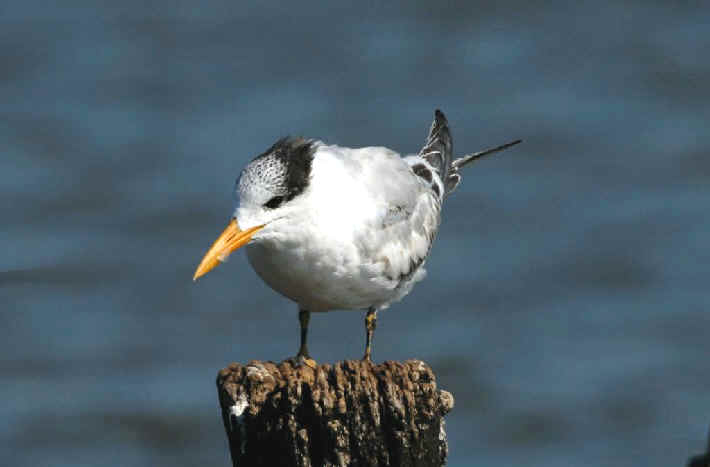
A juvenile Royal Tern
(photo by Howard Eskin)
-
Cayenne Tern (*) ______ PR(rare)
Thalasseus
(formerly Sterna) eurygnatha
The Cayenne Tern was conspecific with the Sandwich Tern.
-
Sandwich Tern (*) (ph) ______ BH
CU
DR:feb,mar,apr,dec GD JM:mar
PR:mar,apr SL
Thalasseus
(formerly Sterna) sandvicensis acuflavida
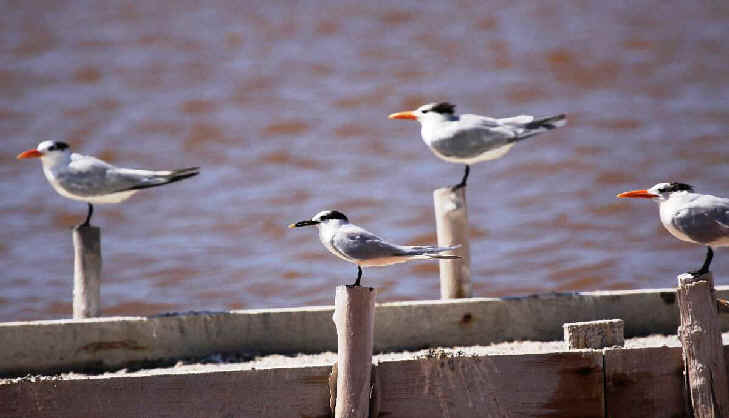
A Sandwich Tern among Royal Terns during the FONT
tour in the Dominican Republic
in February 2012 (photo by Marie Gardner)
-
Caspian Tern (*) (ph) ______ BH CU
DR:feb,mar,apr,dec
HA:apr
PR SL(rare)
Hydroprogne
(formerly Sterna) caspia
(monotypic)
-
Black Tern (*) (ph) ______ BH CU DR:dec
SL
Chlidonias niger surinamensis
As many as 10 Black Terns were at Lago Enriquillo in the
Dominican Republic in September 1999.
- White-winged Tern (ph)
______ BD(very rare) BH(very
rare)
SL(very rare)
Chilidonias leucopterus
2 White-winged Terns were in Barbados in October 1996.
- Whiskered Tern (WIr) (ph) ______
Chilidonias hybrida
- Brown Noddy (p) (*) ______ BH
CU GD MN PR SL
Anous s. stolidus
- Black Noddy ______
SL(rare)
Anous minutus
- Black Skimmer (ph) ______ BH(rare) CU(rare)
SL(very rare)
Rynchops niger
- Pomarine
Jaeger (p) (*) (ph) ______
BH
CU(rare) DM:mar(seen
at sea & from shore) GD JM SL
Stercorarius pomarinus
(monotypic)
In Europe, the Pomarine Jaeger is called the Pomarine Skua.
In the Caribbean, Stercorarius pomarinus
is uncommon during its non-breeding season, from October to May, particularly
off Hispaniola, west of the Lesser Antilles, and in the Bahamas.
A Pomarine Jaeger seen off Cuba on January 17, 1997 was said to
be the 9th or 10th record of the species for that island.
Off Saint Lucia, a Pomarine Jaeger observed during a
whale-watching trip on December 29, 2008 was said to be the fifth record of
the species for that island.
Two Pomarine Jaegers were seen off Jamaica in late 2009.

Pomarine Jaegers
(or
Pomarine Skuas)
have commonly
been seen in the winter
during FONT pelagic trips off Dominica
(a black-and-white photo by Alan Brady)
- Parasitic Jaeger (ph) ______
BD
BH CU(rare) GD
SL
Stercorarius parasiticus
In Europe, the Parasitic Jaeger is called the Arctic Skua.
In the Caribbean, Stercorarius parasiticus
is an uncommon migrant, and a rare resident during its non-breeding season,
from August to May.
A Parasitic Jaeger was seen off Jamaica in late 2009.
3 Parasitic Jaegers were seen from land in Barbados on March 5,
1998.
- Long-tailed Jaeger (ph) ______ BH(rare)
CU(rare) SL
Stercorarius longicaudus
In Europe, the Long-tailed Jaeger is called the Long-tailed Skua.
In the Caribbean, Stercorarius longicaudus
is a very rare migrant from August to October and from March to May. It is
generally well out to sea.
- Great Skua (p) (*) (ph) ______ DM:mar(at
sea) SL(rare)
Stercorarius (formerly
Catharacta) skua
(monotypic)
The Great Skua normally occurs in the Caribbean from
November to May.
- South Polar Skua (ph) ______
SL(at sea)
Stercorarius maccormicki
- Dovekie (WIr) ______
BH(rare) CU(rare)
Alle alle
PIGEONS
- White-crowned Pigeon (nt) (*) ______
AT:feb BH
CU
CY:feb,jun
DR:mar,apr,jul JM:mar,apr PR
Patagioenas (formerly Columba) leucocephala
(monotypic)
In Jamaica, a local name for the White-crowned Pigeon is "Baldpate".
- Scaly-naped (or
Red-necked) Pigeon (*) (ph) ______ BD:jul
CU
DM:jan,feb,mar DR:jan,feb,mar,apr,jul,dec GR PR:feb,mar,apr SL:mar,dec
SV:mar,jul,dec
Patagioenas (formerly Columba) squamosa
(monotypic)

A Scaly-naped Pigeon
photographed in the mountains of the Dominican Republic
during a FONT tour in April 2012
(photo by Marie Gardner)
-
Plain Pigeon (nt) (*) ______ CU
DR:feb,mar,apr,dec JM
PR:feb
Patagioenas
(formerly
Columba)
i. inornata (subspecies on
Hispaniola & Cuba)
Patagioenas
(formerly
Columba)
inornata wetmorei (subspecies endemic to
Puerto Rico)
In Jamaica, a local name for the Plain Pigeon is "Blue
Pigeon".
- Ring-tailed Pigeon (t3) (*)
______ JM:mar,apr (species
endemic
to Jamaica)
Patagioenas
(formerly Columba) caribaea
(monotypic)
A local name for the Ring-tailed Pigeon is "Ringtail".
- Common (or Feral) Pigeon
(i) (*) ______ BH CU CY:feb,jun,dec DM:jan,mar DR:jan,feb,mar,apr,jul,dec
GD:feb HA:apr JM:mar,apr PR:feb,mar,apr SL:mar,dec SV:mar,dec
Columba livia
- Passenger Pigeon ______ (extinct
species;
occurred formerly in Cuba)
Ectopistes migratorius
(was the single member of its genus)
- African Collared Dove (i) (*) ______ PR:feb,mar,apr
(What's
been called the
Ringed Turtle Dove, or the
Barbary Dove, historically native to North
Africa, is said to be a domesticated form, or recessive mutant of this species
that continues in the wild in Africa.)
Streptopelia roseorisea
- Eurasian Collared Dove (i)
(*)
______ AT:feb BH
BU:feb CU CY:dec DM:jan,mar
DR(rare) GD:feb
Streptopelia decaocto
The Eurasian Collared Dove, Streptopelia
decaocto, was introduced in Guadeloupe in 1976, in the
town of Saint-Claude.
Subsequently, it had a substantial range expansion. From the original
population of 20 birds, the dove spread throughout Guadeloupe, and north to
the islands of Montserrat, Nevis, and Barbuda, and south to Martinique.
The subpopulation that was released in Guadeloupe is different than that
released in the Bahamas in the mid-1970s which later colonized first in
Florida (and also Cuba), and then across the North American continent.
The Eurasian Collared Dove has been seen during FONT tours in Guadeloupe
and Dominica, as well as in Antigua, Barbuda, and the Cayman Islands.
Those in the Lesser Antilles were from the birds released in Guadeloupe.
The first Eurasian Collared Doves in Dominica were reported in
Roseau in 1987. Subsequently, the population of the doves in that city
increased considerably.
In Montserrat, the Eurasian Collared Dove became established in
Victoria, where it has bred since 1990.
In the Dominican Republic, what was said to be the first
record of the Eurasian Collared Dove in the country was at Punta Cana in late 2006.
- Mourning Dove (*) (ph) ______ BH CU
DR:jan,feb,mar,apr,jul,dec
HA:feb,apr JM:mar,apr PR:mar,apr
Zenaida m. macroura (this subspecies, the nominate, endemic to the West Indies)
-
Zenaida Dove (*) (ph) ______ AT:feb
BD:jul BH BU:feb
CU CY:feb,jun,dec DM:jan,feb,mar DR:feb,mar,apr,jul
GD:feb JM:mar,apr PR:feb,mar,apr SL:mar,dec SV
Zenaida a. aurita (resident subspecies of the Lesser Antilles)
Zenaida aurita zenaida (resident subspecies of the northern
Caribbean)
In Jamaica, a local name for the Zenaida Dove is "Pea
Dove".

Zenaida Dove
(photographed by Marie Gardner in Saint Lucia
during the Dec 2007 FONT Lesser Antilles Tour)
- Eared Dove (*) (ph) ______
GD(very rare) GR
SL:mar,dec SV:mar,jul,dec
Zenaida auriculata rubripes
(subspecies of the Lesser Antilles &
northern South America)
On Guadeloupe, a juvenile Eared Dove was seen on September 10,
2008, after a singing adult male had been found earlier in the year at the
Petite-Terre Natural Reserve.

Eared Dove
(photographed by Marie Gardner in Saint Vincent
during the Dec 2007 FONT Lesser Antilles Tour)
- White-winged Dove (*) (ph) ______
BH
CU CY:feb,jun,dec DM(rare)
DR:feb,mar,apr,jul,dec GD JM:mar,apr PR:feb,mar,apr
Zenaida a. asiatica
In Jamaica, a local name for the White-winged Dove is "White-wing".
In the Lesser Antilles, what is said to have been the first record of
the White-winged Dove for Dominica was in January 2005, with the
species seen there again in May of that year.
In Guadeloupe, there have been numerous sightings of White-winged
Doves since July 2005, but mainly since April of the following
year.
-
Caribbean Dove (*) ______
BH CY:feb
JM:mar
Leptotila jamaicensis collaris (subspecies
endemic to the Cayman Islands)
Leptotila j. jamaicensis (subspecies
endemic to Jamaica)
In Jamaica, a local name for the Caribbean Dove is "White-belly".
- Grenada Dove (t1) (LAe) (*) ______ GR
(species endemic to Grenada)
Leptotila wellsi (monotypic)
The Grenada Dove is closely related to the Gray-fronted
Dove of Central & South America, Leptotila
rufaxilla, and has been said by some to be conspecific with it.
- Common Ground Dove (*) (ph) ______
AT:feb BD:jul BH
CU
BU:feb CY:feb,jun,dec DM:jan,feb,mar DR:jan,feb,mar,apr,jul,dec
GD:feb GR
HA:feb,apr JM:mar,apr PR:feb,mar,apr SL:mar,dec SV:mar,jul,dec
Columbina passerina antillarum (subspecies on Barbados, Grenada, St.
Lucia, & St. Vincent)
Columbina passerina nigrirostris
(subspecies endemic to Dominica)
Columbina passerina insularis (subspecies in Hispaniola, Cuba, the
Cayman Is., & some other small islands)
Columbina passerina jamaicensis (subspecies endemic to Jamaica)
Columbina passerina portoricensis (subspecies in Puerto Rico & the Virgin Islands)

A Common Ground Dove, not on the ground
(photographed by Marie Gardner in Saint Lucia
during the Dec 2007 FONT Lesser Antilles Tour)
-
Ruddy Quail-Dove (*) ______ CU
DM:feb,mar DR;apr
JM:apr PR:apr SL SV:dec
Geotrygon m. montana (the same subspecies as in Central & South America)
In Jamaica, a local name for the Ruddy Quail-Dove is "Partridge".
-
Bridled Quail-Dove (*) ______ PR
SL SV:mar
Geotrygon mystacea (monotypic)
- Key West Quail-Dove (*) ______
BH
CU DR:feb,mar,apr,jul
PR:apr
Geotrygon chrysia
(monotypic)
- White-fronted Quail-Dove (t3)
(*) ______
DR:mar,apr (species endemic to Hispaniola)
Geotrygon leucometopia
The White-fronted Quail-Dove was conspcific with the
Gray-fronted Quail-Dove of Cuba (below), Geotrygon
caniceps.
When combined, it was called the Gray-headed Quail-Dove.
- Gray-fronted Quail-Dove (t3) ______
CU (species
endemic to Cuba)
(see noted with previous species)
Geotrygon caniceps
- Blue-headed Quail-Dove (t2) ______
CU (species endemic to Cuba)
Starnoenas cyanocephala
- Crested Quail-Dove (nt) (*)
______
JM:apr (species endemic to Jamaica)
Geotrygon versicolor (monotypic)
A local name for the Crested Quail-Dove is "Mountain
Witch".
PARAKEETS
and PARROTS
- Cuban Red (or Hispaniolan)
Macaw ______ (species
extinct)
Ara tricolor
Regarding the CUBAN RED, or HISPANIOLAN MACAW, go to:
RARE & NOW EXTINCT
BIRDS OF THE CARIBBEAN
- Monk Parakeet (i) (*) ______ CY:feb PR:feb,mar
(native to
south-central South America)
Myiopsitta monachus
- White-winged
Parakeet (i) (*) ______ PR
(native to north-central South America)
Brotogeris (v.) versicolurus
The White-winged Parakeet was previously considered conspecific
with the Canary-winged Parakeet, also of South
America.
- Jamaican Parakeet (or Conure)
(*) ______
DR:feb,mar,apr,jul,dec JM:mar,apr (species
was
endemic to Jamaica)
Eupsittula (formerly Aratinga) nana
The Jamaican Parakeet was conspecific with what is now the Aztec
Parakeet, or Conure, of Central America, Aratinga
astec. When merged, it was known as
the Olive-throated Parakeet, or Conure.
- Hispaniolan Parakeet (or Conure) (t3)
(*) (ph) ______
DR:jan,feb,mar,apr,dec (species
endemic
to Hispaniola)
Psittacara (formerly Aratinga) c. chloroptera
(another subspecies on Mona
Island, off western
Puerto Rico, now extinct)

A Hispaniolan Parakeet during the FONT
Dominican Republic tour in February 2012
(photo by Marie Gardner)
- Cuban Parakeet (t3) ______
CU (species endemic to
Cuba)
Psittacara
(formerly Aratinga) euops
- Orange-fronted Parakeet (or Conure) (i)
(*) ______
PR:feb
(native to Central America)
Eupsittula
(formerly Aratinga) canicularis
-
Mitred Parakeet (or Conure) (i) (*) ______ PR
(native to south-central South America)
Psittacara
(formerly Aratinga) mitrata
- Green-rumped
(or Guiana)
Parrotlet (i) (*) ______ JM:mar
Forpus passerinus
- Puerto Rican Amazon (or Parrot)
(t1)
(*) ______
PR:feb.mar (species a rare endemic to Puerto
Rico)
(see note following list)
Amazona v. vittata
(a second subspecies on Culebra Island,
A. V.
gracilipes,
now extinct)
Regarding the PUERTO RICAN AMAZON, go to: RARE BIRDS OF
THE CARIBBEAN
- Rose-throated Amazon (or
Parrot) (nt) (*)
(ph)
______ BH CU CY:feb,jun,dec
Amazona leucocephala caymanensis (an
endemic subspecies on Grand Cayman Island)
Amazona leucocephala hesterna (an
endemic subspecies on Cayman Brac Island)
Amazona leucocephala leucocephala (an endemic subspecies
in Cuba)
Amazona leucocephala bahamensis (an endemic subspecies in
the Bahamas, on Great Inagua and Abaco Islands)
Amazona leucocephala has
various names on different islands in its range, including:
"Cayman Amazon (or Parrot)", and "Bahama
Amazon (or Parrot)".

The Cayman, or Rose-throated, Amazon
In the Caribbean, there are, as noted above, 4 subspecies.
2 of them are in the Cayman Islands.
The other 2 are in the Bahamas & Cuba.
- Imperial Amazon (or Parrot)
(t2) (LAe) (*)
______ DM:jan,feb,mar (species endemic to Dominica)
Amazona imperialis (monotypic)
A local name for the Imperial Amazon is the "Sisserou".
Regarding the IMPERIAL AMAZON, go to: RARE BIRDS OF THE CARIBBEAN
- Red-necked Amazon (or Parrot) (t3) (LAe)
(*) ______ DM:jan,feb,mar (species
endemic to Dominica) (species
endemic to Dominica)
Amazona arausiaca (monotypic)
Local names for the Red-necked Amazon are "Jaco"
or "Perroquet". The species has also been called "Bouquet's
Amazon".
- Hispaniolan Amazon (or Parrot) (t3) (*)
(ph)
______
DR:feb,mar,apr,jul,dec (species
endemic to
Hispaniola)
Amazona ventralis (monotypic)

An orphaned Hispaniolan Amazon that has since
bonded with "a friend".
One of the two creatures in this photo is endemic to Hispaniola.
The man is from Italy. The parrot is from the area of a national park,
near
Boca de Yuma, in the eastern Dominican Republic where this photo was
taken.
(photo by Marie Gardner during the April 2012 Dominican Republic
Tour)
- Yellow-billed Amazon (or
Parrot) (nt)
(*) (ph) ______
JM:mar,apr
(species endemic to Jamaica)
Amazona collaria (monotypic)

Yellow-billed Amazon
(photo by Suzanne Bradley)
- Black-billed Amazon (or Parrot)
(t3)
(*) ______ JM:mar,apr (species
endemic
to Jamaica)
Amazona agilis (monotypic)
- Saint Lucia
Amazon
(or Parrot) (t3) (LAe) (*) ______ SL:mar,dec
(species endemic to St. Lucia)
(species endemic to St. Lucia)
Amazona versicolor (monotypic)
A local name for the Saint Lucia Amazon is the "Jacquot".
The species has also been called the Versicolored Amazon.
- Saint Vincent Amazon (or
Parrot) (t3) (LAe)
(*) (ph) ______ SV:mar,jul,dec (species
endemic
to St, Vincent) (also called "Guilding's Amazon")
Amazona guildingii
Another name for the Saint Vincent Amazon is "Guilding's
Amazon".


Above: the colorful Saint Vincent Amazon,
photographed during the FONT tour in December 2007.
Top photo: a captive bird in the botanical garden.
Middle photo: in the wild, in the forest.
(photos by tour participant, Marie
Z. Gardner)
Below: Saint Vincent Amazons on a postage stamp

- Orange-winged Amazon (or Parrot) (i)
(*) ______ PR
(native to north-central South America)
Amazona amazonica
- Yellow-headed Amazon (or Parrot)
(i) (*) ______
PR
(native to Mexico & Belize)
Amazona oratrix
- Yellow-shouldered Amazon ______
NA
Amazona barbadensis
In the Netherlands Antilles, the Yellow-shouldered Amazon
occurs mainly on Bonaire, where as of 2012 there was a population of
over 600 birds.
CUCKOOS
-
Mangrove Cuckoo (*) (ph) ______ BU:feb
BH CU
CY:feb,jun
DM:jan,mar DR:feb,mar,apr,dec GD:feb GR JM:apr PR:mar,apr SL:mar,dec
SV:mar
Coccyzus minor (now said to be monotypic, formerly subspecies in the West
Indies: Coccyzus minor nesiotes)

Mangrove Cuckoo
(photo by Marie Grenouillet)
-
Yellow-billed Cuckoo (*) ______ BH CU PR:apr
SL
Coccyzus americanus (monotypic)
- Black-billed Cuckoo ______ BH(rare) CU
DR(rare)
Coccyzus erythropthalmus
A Black-billed Cuckoo was at Cabo Rojo in the Dominican Republic
in September 1999.
- Hispaniolan Lizard Cuckoo
(*) (ph) ______ DR:feb,mar,apr,jul,dec
(species endemic to Hispaniola)
Coccyzus (formerly
Saurothera) l. longirostris (the other subspecies on the small islands La
Mohotiere & Gonave off the Dominican Republic)
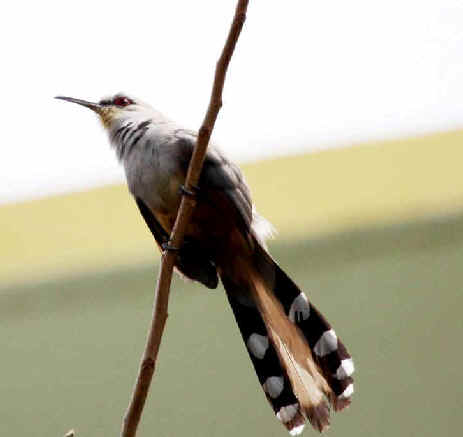
Above & below: Hispaniolan Lizard Cuckoos
Above: one on a wire during the FONT Dominican Republic Tour in April 2012
Below: one on the ground during the February 2012 FONT Dominican Republic Tour
(photos by Marie Gardner)

- Jamaican Lizard Cuckoo (*) (ph) ______
JM:mar,apr (species endemic to Jamaica)
Coccyzus
(formerly Saurothera) vetula (monotypic)
A local name for the Jamaican Lizard Cuckoo is "Old
Woman Bird".

A Jamaican Lizard Cuckoo photographed during a FONT tour
- Puerto Rican Lizard Cuckoo (*) ______
PR:feb,mar,apr
(species endemic to Puerto Rico)
Coccyzus (formerly Saurothera) vieilloti
(monotypic)
- Great Lizard Cuckoo ______
BH
CU
Coccyzus (formerly Saurothera) merlini
- Bay-breasted Cuckoo (t2)
(*) ______
DR:feb,mar,apr,jul (species endemic to the
Dominican Republic on Hispaniola)
Coccyzus
(formerly
Hyetornis)
rufigularis (monotypic)
Regarding the BAY-BREASTED CUCKOO, go to:
RARE BIRDS OF
THE CARIBBEAN
- Chestnut-bellied Cuckoo (*) ______ JM:mar,apr
(species endemic to Jamaica)
Coccyzus
(formerly Hyetornis) pluvialis
(monotypic)
A local name for the Chestnut-bellied Cuckoo is "Old
Man Bird".
- Smooth-billed Ani (*) (ph) ______
BH
CU CY:feb,jun,dec
DM:mar DR:jan,feb,mar,apr,jul,dec GR JM:mar,apr
PR:feb,mar,apr
SL SV:mar,dec
Crotophaga ani (monotypic)
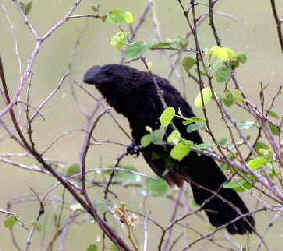
A Smooth-billed Ani photographed during a FONT tour
- Greater Ani (WIr) ______ VI(very
rare)
Crotophaga major
2 photographed Greater Anis
were in Curacao, in the Netherlands Antilles, on October 26,
2010, in mangroves near the island's harbor, as apparently the first record of
that normally South American species for the island.
That same day, October 26, 2010, further north in the Caribbean, one Greater
Ani was photographed in a brackish wetland on St. Croix in the US
Virgin Islands. It was a first record for those islands, and way north of
the normal range of the species.
OWLS
- American Barn Owl (*) (ph) ______ BH CU
CY:dec DR:mar,apr JM:mar,apr
PR
Tyto furcata
The American Barn Owl has been part of the Barn Owl of Eurasia &
Africa, Tyto alba.
But Tyto furcata is a heavier bird,
with a larger and stouter head and body, and with much more powerful
talons.
Tyto furcata furcata ______
(subspecies in Jamaica, Cuba, and the Cayman Islands)
Tyto furcata pratincola _____ (subspecies in Hispaniola & Puerto Rico, also in North & Central America)

An American Barn Owl photographed during a FONT tour
(photo by Andy Smith)
- Lesser Antilles Barn Owl (*) ______ DM:mar
SL SV:mar
Tyto insularis
The Lesser Antilles Barn Owl was considered a subspecies of
Tyto alba, the Barn Owl of Eurasia & Africa.
The taxonomic status of Tyto insularis
is still considered uncertain and more DNA work should be done, but it
is now separated from Tyto furgata
(the American Barn Owl) and Tyto glaucops
(the Ashy-faced Owl) on the basis mainly of its isolated distribution
and morphological differences.
Tyto insularis has a rather dark
plumage with brownish underparts and a dark grayish veil on the back and
wings.
Two subspecies are recognized:
Tyto insularis insularis
______ (on St. Lucia, St. Vincent, Grenada, and a few islands of the
Grenadines)
Tyto insularis nigrescens
______ (on Dominica, this race having hardly any white spots
above)
- Curacao Barn Owl ______
(species endemic to Curacao, in the Netherlands Antilles)
Tyto bargei
The Curacao Barn Owl is considerably smaller than the American
Barn Owl.
A yet un-named race of the American Barn Owl on the nearby Bonaire
Island is bigger and has large unfeathered feet and a long tarsus and
bill.
- Ashy-faced Owl (*)
______ DR:feb,mar,apr,dec (species
endemic
to Hispaniola)
Tyto glaucops (monotypic)
- Puerto Rican Screech Owl (*) (ph) ______ PR:feb,mar,apr
(species endemic to Puerto Rico & the Virgin Islands)
Megascops
(formerly Otus) nudipes
Megascops nudipes nudipes
______ (subspecies
endemic to Puerto Rico & adjacent islands)
Megascops nudipes newtoni
______ (subspecies endemic to the
Virgin Islands, on St. Thomas, St. John, & St, Croix; less vermiculated
and less streaked below than M. n, nudipes)

A Puerto Rican Screech Owl photographed during a FONT
tour
- Bare-legged Owl ______ CU
(species endemic to Cuba)
Margarobyas lawrenci
(the only member of its genus)
The Bare-legged Owl has been known as the Cuban Screech
Owl.
- Cuban Pygmy Owl ______
CU
(species endemic to Cuba)
Glaucidium siju
- Burrowing Owl (*) (ph) ______
BH
CU DR:mar,apr,jul,dec
Athene cunicularia troglodytes
(subspecies endemic to Hispaniola; 2
other West Indian subspecies have been extirpated, in Antigua and Guadeloupe)
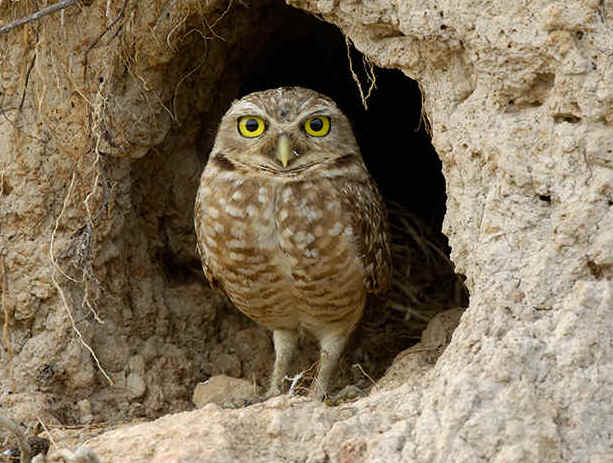
Above: A Burrowing Owl, in a burrow in the Dominican Republic
Below: 2 very young Burrowing Owls during the FONT tour
in the Dominican Republic in April 2012
They were in a hole in the ground, and were put back in
quickly after the photograph. We left promptly so as not to
further disturb.

- Stygian Owl ______ CU
DR
Asio stygius siguapa
(subspecies on Cuba & Hispaniola)
Asio stygius siguapa is
smaller than the two mainland subspecies of the Stygian Owl in Central
& South America.
It also has whiter markings.
Overall, the Stygian Owl is poorly known and needs further
study.
- Short-eared Owl ______ BH(rare) CU
DR
Asio flammeus domingensis
(subspecies on Cuba, Hispaniola, & Puerto Rico)
Asio flammeus domingensis is
smaller than the nominate Asio flammeus flammeus,
and has very fine streaks on the belly and a darker ruff.
This West Indian subspecies is sometimes considered a full species due to its
plumage and vocalizations.
- Jamaican Owl (*) ______
JM:mar
(species endemic to Jamaica)
Pseudoscops grammicus
(monotypic)
A local name for the Jamaican Owl is "the Patoo,
with big eyes".
POTOO
and NIGHTJARS, NIGHTHAWKS
- Northern
Potoo (*) (ph) ______ CU(rare)
DR:mar,apr JM:mar,apr
Nyctibius jamaicensis abbotti (subspecies
endemic to Hispaniola)
Nyctibius j. jamaicensis (subspecies
endemic to Jamaica)
In Jamaica, a local name for the Northern Potoo is "the
Patoo, with a long bill".
Following findings in western Cuba, the Northern Potoo was
found at 2 localities in far-eastern Cuba in January 2001.

A Northern Potoo photographed during a FONT tour in
Jamaica
(photo by Howard Lebo)
- Chuck-will's-Widow (*) ______
BH
CU DR;feb,apr,dec
PR:feb
Antrostomus (formerly
Caprimulgus) carolinensis (monotypic)
A Chuck-will's-Widow found incubating two eggs on Grand Bahama
Island on June 1, 1999 was the first breeding record for the West
Indies.
Since then, it has been learned that the species is more widespread and
numerous in the northern islands of the Bahamas than previously
thought, not just as a winter visitor but as a breeder in the
summer.
- Eastern Whip-poor-will
______ CU CY:dec
Antrostomus (formerly Caprimulgus) vociferus
- "Saint Lucia Nightjar"
(*) (ph) ______
SL
Antrostomus (formerly Caprimulgus) rufus otiosus (t2)
(an endemic subspecies on St. Lucia)
The "Saint Lucia Nightjar" is a subspecies of the
Rufous Nightjar, a species that occurs throughout much of South America.

Rufous Nightjar, photographed during a FONT tour
(photo by Marie Gardner)
- "Hispaniolan Nightjar"
(*) ______ DR:mar,apr,jul,dec
(endemic subspecies to Hispaniola)
Antrostomus
(formerly Caprimulgus) cubanensis ekmani
The "Hispaniolan Nightjar" is generally considered
conspecific with the "Cuban Nightjar" (below), C.
c. cubanensis, and is thus properly called the Greater
Antillean Nightjar.
- "Cuban Nightjar" ______
CU (endemic subspecies in Cuba)
Antrostomus
(formerly Caprimulgus) c. cubanensis
- Puerto Rican Nightjar (t2) (*) ______ PR:feb,mar,apr
(a rare endemic to Puerto Rico)
Antrostomus (formerly
Caprimulgus) noctitherus (monotypic)
Regarding the PUERTO RICAN NIGHTJAR, go to: RARE BIRDS OF THE CARIBBEAN

Puerto Rican Nightjar
- Least Poorwill (t3) (*) ______ DR:mar,apr,jul,dec (endemic
to Hispaniola) (has been called Least Pauraque)
Siphonorhis brewsteri (monotypic)
(The only other member of this genus, the Jamaican Pauraque,
may be extinct.)
- Antillean Nighthawk (*) ______
BH
CU
CY:jun DR:mar,apr,jul GD(rare) JM:apr PR
Chordeiles g. gundlachii (this subspecies of
the Greater Antilles, the other of Florida & the Bahamas)
In Jamaica, a local name for the Antillean Nighthawk is "Gimme-me'bit",
similar to the call made by the bird as it flies often high in the
sky.
An Antillean Nighthawk on Guadeloupe in June 2000 was
said to be the first record of the species for that island.
The following month (in July 2000), 2 Antillean Nighthawks were
observed there, raising the possibility of the species breeding.
- Common Nighthawk (*) ______
BH
CU DR:apr
Chordeiles minor (6
subspecies migrate thru the Caribbean between North & South America)
SWIFTS
- White-collared Swift (*) ______
CU DR:feb,mar,apr,dec
JM:mar
Streptoprocne zonaris pallidifrons (the
subspecies of the Caribbean)
- American Black Swift (*) ______
CU DR:feb,mar,apr,jul
JM:apr PR SL SV:mar
Cypseloides n. niger (the subspecies of the
Caribbean & Trinidad; present there during its breeding season)
- Chimney Swift (*) ______
BD(very rare) BH
CU(rare) CY
Chaetura pelagica (monotypic)
A Chimney Swift on Barbados in November 2005 was
said to be the third record for that island.
Two exhausted Chimney Swifts in Cuba in October 1998 were the
first specimens of the species for that island.
A live Chimney Swift was seen in flight south of Matanzas, Cuba
on April 14, 2000.
- Short-tailed Swift (*) ______
SL(rare) SV
Chaetura brachyura praevelox (this subspecies on St. Vincent, Grenada,
& Tobago)
In April 2009, the Short-tailed Swift was observed for the first
time in Saint Lucia. Two flocks were noted that month:
one of 4 over Soufriere on April 1, and one of 8 seen above the Aerial Tram in
Babbonneau on April 18.
- Lesser Antillean Swift (LAe) (*)
______ DM:jan,feb,mar
SL:mar,dec SV
Chaetura martinica (monotypic)
- Gray-rumped Swift ______ GR
Chaetura cinereiventris
The Gray-rumped Swift is locally common on Grenada, where it seems
to be seasonal.
- Antillean Palm Swift (*)
______ CU DR:jan,feb,mar,apr,jul,dec
JM:mar,apr
Tachornis p. phoenicobia (the
subspecies of Hispaniola & Jamaica; the other is of Cuba)
- Alpine Swift (WIr) ______
BD(very rare)
Apus melba
Alpine Swifts, from the Old World, were seen in Barbados in 2003
from June 21 to July 9 (photographed), and in 2005 on July 31, marking the
second and third occurrences for that island, and the 6th & 7th records
for the Western Hemisphere.
HUMMINGBIRDS
- Rufous-breasted Hermit ______ GR
Glaucis hirsuta
The Rufous-brested Hermit is a fairly common resident on Grenada,
at over 1500 feet above sea level.
- Hispaniolan Emerald (*) (ph)
______ DR;feb,mar,apr,jul,dec
(species endemic to Hispaniola)
Chlorostilbon swainsonii (monotypic)

A female Hispaniolan Emerald photographed
during
a FONT tour in the Dominican Republic in February 2012
(photo by Marie Gardner)
- Puerto Rican Emerald (*) ______
PR:feb,mar,apr
(species endemic to Puerto
Rico)
Chlorostilbon maugaeus (monotypic)
- Cuban Emerald ______ BH CU
Chlorostilbon ricordii
- Antillean Mango (*) (ph) ______ DR:jan,feb,mar,apr,jul,dec
HA:apr
PR:feb,mar,apr
Anthracothorax d. dominicus
(subspecies
endemic to Hispaniola)
Anthracothorax dominicus aurulentus
(subspecies endemic to Puerto Rico)

A juvenile Antillean Mango photographed during a FONT
tour
in the Dominican Republic in February 2012
(photo by Marie Gardner)
- Jamaican Mango (*) ______
JM:mar,apr (species
endemic
to Jamaica)
Anthracothorax mango (monotypic)
- Green Mango (*) ______ PR:feb,mar,apr
(species endemic to Puerto Rico)
Anthracothorax viridis (monotypic)
- Green-breasted Mango ______
Anthracothorax prevostii
- Blue-headed
Hummingbird (LAe) (*) ______ DM:jan,feb,mar
(species restricted to the 2 islands of Dominica & Martinique)
Cyanophaia bicolor (monotypic, and the single member of its genus)
- Purple-throated Carib (LAe) (*) (ph)
______ DM:jan,feb,mar SL:mar,dec
SV:mar,jul,dec
Eulampis jugularis (monotypic)
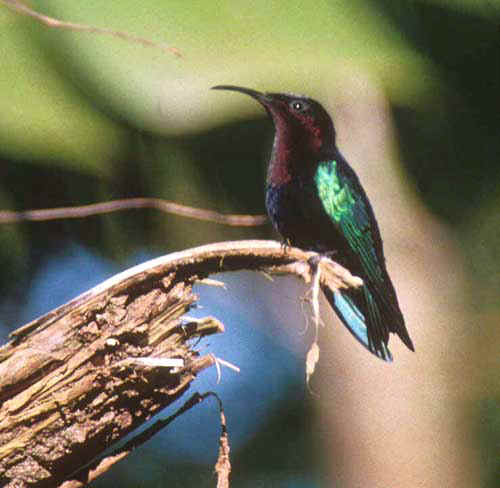
A Purple-throated Carib photographed during a FONT
tour
- Green-throated Carib (*) (ph) ______
AT:feb DM:jan,mar
PR:feb,mar,apr SL:mar,dec SV:mar,jul,dec
Eulampis h. holosericeus (subspecies in
east Puerto Rico & in most of the Lesser
Antilles)

A Green-throated Carib photographed during a FONT tour in St. Lucia in Dec
2007
(photo by Marie Gardner)
-
Antillean Crested Hummingbird (*) (ph) ______ AT:feb
BU:feb BD:jul DM:jan,feb,mar GD:feb GR PR:feb,mar,apr SL:mar,dec SV:mar,jul,dec
Orthorhyncus cristatus exilis
(subspecies in Puerto Rico & in most of the Lesser
Antilles, including Dominica & St. Lucia)
Orthorhyncus c. cristatus
(subspecies endemic to Barbados)
Orthorhyncus cristatus emigrans (subspecies endemic to Grenada)
Orthorhyncus cristatus ornatus
(subspecies endemic to St. Vincent)
(on Grenada blue-crested, on other islands green-crested)
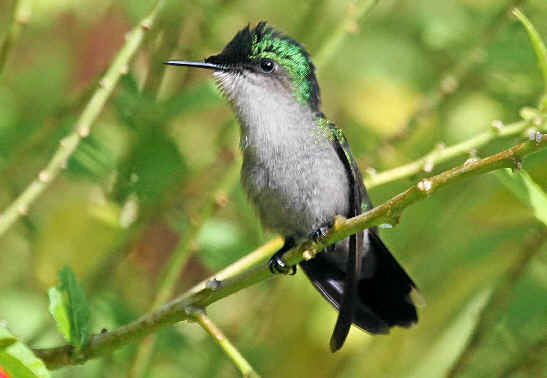
A female Antillean Crested Hummingbird
photographed during a FONT tour in St. Lucia in Dec 2007
(photo by Marie Gardner)
- Red-billed Streamertail (*)
(ph) ______ JM:mar,apr
(species endemic to Jamaica)
(the two streamertails have been considered conspecific)
Trochilus polytmus
(monotypic)
The Red-billed Streamertail and the Black-billed Streamertail
(below) have been considered conspecific.
A local name for the streamertails is the "Doctorbird".
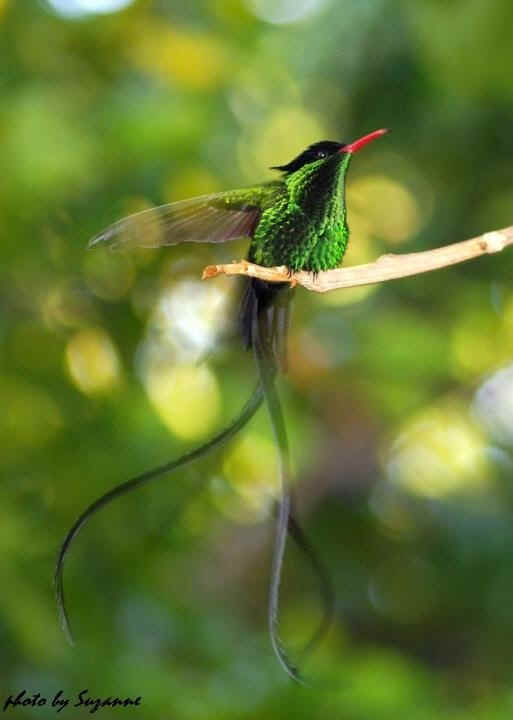
Above & below: Red-billed Streamertails
Above a male, below a female
(photos by Suzanne Bradley)

- Black-billed Streamertail (*) ______ JM:mar,apr
(species endemic to Jamaica)
Trochilus scitulus
As noted above, the two streamertails were considered
conspecific, with the Black-billed Streamertail as a subspecies of the Red-billed
Streamertail.
- Vervain
Hummingbird (*) (ph) ______ DR:feb,mar,apr,jul
JM:mar,apr
Mellisuga minima vieillota (subspecies
endemic to Hispaniola & nearby small islands)
Mellisuga m. minima (subspecies endemic to Jamaica)
In Jamaica, a local name for the Vervain Hummingbird is the "Little
Doctorbird".

Above: Way up high in a tree, sitting
and calling,
a Vervain Hummingbird, the second smallest hummingbird
in the Caribbean after the Bee Hummingbird of Cuba.
Below: Down low, another Vervain Hummingbird,
feeding on a flower. Notice the little feet.
Both photos were taken during the FONT tour
in the Dominican Republic in April 2012.
(photos by Marie Gardner)

- Bee Hummingbird (nt) ______
CU (species
endemic
to Cuba) (This species is reputed to be the
smallest bird in the world.)
Mellisuga helenae
- Bahama Woodstar ______
BH CU(very rare)
Calliphlox evelynae (has been C.
e. evelynae as there have been two subspecies prior to the split of
the species that follows, now here as the Inaguan Lyretail)
The Bahama Woodstar is a member of the North American branch of
the Bee Hummingbird group: MELLISUGINI.
It inhabits the islands of the Bahamas, and the Turks and Caicos except on
Great and Little Inagua Island. On those Inaguan islands, what is now here as
the Inaguan Lyretail (below) has been considered a subspecies of
the Bahama Woodstar.
An article published in 2008 relates the first known record of the Bahama
Woodstar in Cuba, on the Cayo Paredon Grande, off the north coast of the
Cuban mainland.
- Inaguan Woodstar ______ BH
Calliphlox lyrura
The Inaguan Woodstar occurs only on the islands of Great and Little
Inagua. It has been a subspecies of the Bahama Woodstar.
Another name, Inaguan Lyretail, relates to the bird's distinctive,
lyre-shaped outer tail feathers (of the male).
- Ruby-throated Hummingbird (ph)
______ BH CU CY
Archilochus colubris
Notes:
Our Puerto Rico tour in February 1990 included a trip (by air) to uninhabited
Mona Island,
off the west coast of Puerto Rico, about mid-way between Puerto Rico and the
Dominican Republic. Birds found only there noted by an (mi).
A few of our Puerto Rico tours have included a trip by ferry to Culebra
Island, off northeastern
Puerto Rico, about mid-way between Puerto Rico and the Virgin Islands.
During our Feb 6-11, '96 Puerto Rico tour, we conducted our first Caribbean pelagic trip
off the west coast of the island.
A Black-capped Petrel was seen.
(Only 3 records in Raffaele's book: "Birds of Puerto Rico".) Also
whales and dolphins.
During the pelagic trip with our Feb 15-19 tour, about 300 boobies.
Over 200 of them, Red-footed (both brown & white morphs).
Also a 60-foot
Whale Shark by the boat.
With the pelagic trip during the March '96 tour, 6 species of terns were seen.
Inexplicably, a male Baikal Teal was in a large flock of Blue-winged
Teal on Feb 24, 2001 on a pond on Little Cayman Island, a small, remote
place with few people. The behavior of the Baikal Teal was the same as that of
the Blue-winged Teal (as a wary, wild bird). The Feb 2001 Baikal Teal was
not banded. It was photographed. As far as we know, there was no previous record
of this species in the West Indies. The species in Asia has been known to wander
on occasion to the south beyond its normal range. It has occurred in North
America, particularly Alaska, casually. The Feb 2001 Little Cayman bird may have
joined with Blue-winged Teal in western North America and migrated south with
them. Also it should be noted that Baikal Teals have occurred in North America
as escapes.
12 of the very rare Puerto Rican Amazons were seen during FONT Puerto
Rican tour #12, in March 1996.
Subsequently, the species has become more
difficult to see in the wild. 3 were seen during tour #18, in March 1998.
The
species was seen again during tour #22, in March 2000.. One wild bird was seen
during tour #26, in March 2004.
The Dunlin has probably been observed only rarely in the Dominican
Republic. The book "A Guide to the Birds of the West Indies" indicates
no sightings, although it notes some records to the west in Cuba and to the east
in Puerto Rico. 2 birds were seen during the FONT tour on December 28, 1998 at
Salinas, along the southern DR coast, west of Santo Domingo.
Jamaican (formerly Olive-throated) Parakeets
were first found during our FONT tours in the Dominican Republic in July
1995, with a substantial number (15-20) in a wild, remote area in the western
part of the country, at mid-elevation in the Baoruco Mountains. Also during that
tour, 1 was found in a flock of Hispaniolan Parakeets in the
city of Santo Domingo.
During all FONT Dominican Republic tours since 1995 in the Baoruco Mountains, the
Jamaican Parakeet
has been seen.
To Top of Page

























































































